#cds result 2015
Text
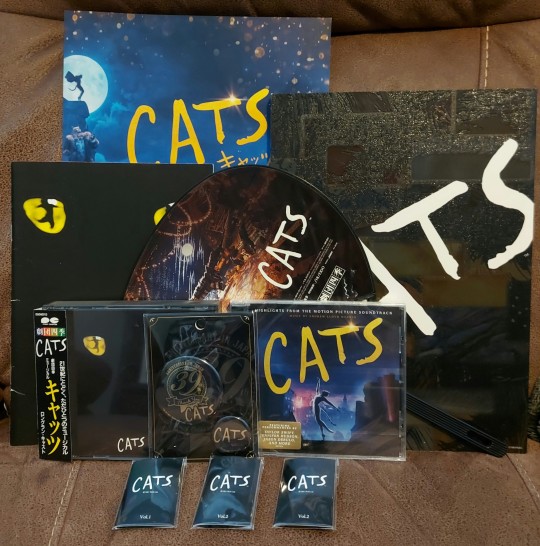
In honour of me hitting 400 followers here, and after a bit of organization of my merchandise 'archives', I have grouping of CATS items to give away that one lucky kitty will win! An eclectic mix, mainly from Japan, including:
Tokyo March 2006 Programme
CATS (2019) Japanese Movie Programme
London Palladium Programme from January/February 2015
Three Shiki Secret Charms from the recent Nagoya run (you get to choose from Victoria, Jennyanydots, Jemima, Mungojerrie, Rumpleteazer, Old Deuteronomy, Rumpus Cat, and Coricopat! See what they look like below the cut)
A brand new 39th anniversary button set from Japan
A promotional handfan from Tokyo in 2007
Japanese 1989 2CD Cast Recording
(Sealed) CATS (2019) Highlights from the Motion Picture Soundtrack CD
A smaller bonus item or two 😸
RULES (Please read these carefully and follow them):
1. Entries will open today and will close end of day (EST) August 30th - in one week. You can enter at any time between now and then, but anything after than date will not be counted.
2. Please only ONE entry per person. When you reblog THIS post, you will be assigned a random number, and the receiver will be picked by a random generator to make it fair for everyone. Likes do not count as entries. Multiple reblogs will result in disqualification. I want everything to be as fair as possible!
3. It will be free shipping within North America to receive your prize. This giveaway is open to individuals overseas as well, but I may ask for half of any shipping charges, as they can get expensive. This is especially true if you want to ensure delivery! Tracking is not cheap unfortunately and worldwide mail delivery can be very slow if not sent by air. Any import fees are not controlled by me, so please keep that in mind, even if marked as a gift.
4. You must be comfortable with providing me with shipping information. Rest assured you will be providing me this information in confidence and I will not share it with anyone. If you are not comfortable sharing this information, please do not enter as I will not be able to send it to you.
A winner will be selected on August 31st, and they will receive a message indicating that The Everlasting Cat blessed them with a prize. It will be publicly announced as well. I will ship them out to you within one or two days and will give an update once that happens.
I have been selling items online for more than eight years now, and I do my absolute best to have my packages arrive safely. While I would feel terrible if the package becomes lost, without tracking I cannot do anything except say sorry.
Good luck to everyone who enters!


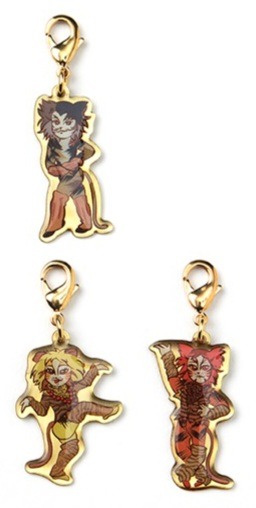


#CATS Musical#CATS the Musical#Thank you to everyone who follows along here to see The Kitties!#It is not much but it is still fun!
136 notes
·
View notes
Note
Is it just me or is Diabolik Lovers losing the popularity it once had?…
// Uhm… that depends. Even if there are still some enthusiasts who would purchase any merch released by Rejet and support the franchise, the volume is obviously lower than in previous years. Nevertheless, they’re not doing that bad for now.
Most people found out about DL when they were still quite young, whether they were from the West or Japan. Teenagers often have more free time, which allows them to engage in whatever they want and create content as a result. But as you get older, your schedule will fill up faster. Many DL fans have begun attending college, landing jobs, or even starting families, making it difficult to maintain a fan account in these circumstances. After all, that isn't intended to be a top priority.
The year 2015 saw the peak of DL's popularity; it received a lot of love and fan support. However, after the release of LE, everything changed. That game got so many negative reactions to the point that fans started boycotting it. I’m sure not everyone meant that in an intentional way but due to the critics, which weren’t just “this game is bad” but rather “this game makes me feel sick/dizzy/too sad etc.”, a lot of people didn’t buy the game and were influenced to dislike it. It became the lowest ranked DL game ever and yeah, they lost plenty of fans with it. Rejet published CL in 2019, but although being more well-liked than LE, it didn't generate as much excitement as previous DL games did because a big number of fans still hadn’t returned.
Moreover, preferences change, opinions change and, most importantly, people change. Only because they liked something 10 years ago, there is no guarantee that they still like it 10 years later and there’s nothing wrong with that.
Otome games became more popular than in the past, therefore a bunch of new ones were released, which piqued the audience's curiosity. Otomate seems to lead with their games, since most of their characters are extremely loved and talked about both in Japan and the West right now and that honestly makes sense because people will undoubtedly be more interested in newer things.
Something seems to happen to Rejet because they got a lot of complaints from fans for: mixing up merchandise packaging, selling merchandise with flaws, delaying a number of things, messing up the voices in various CD dramas, and other things. They did, however, apologize, but I do agree that going through all of that must definitely be a bad experience.
And last but not least, maybe some people are just not active right now. It’s still summer for most of us, so a lot of individuals will most likely choose to enjoy it rather than spend all of their time online. Many of my friends have temporarily stepped away from Tumblr, but they will return as soon as they feel like it. Remember guys: fan accounts should be just for fun and leisure, not something that forces you not to have a social life.
108 notes
·
View notes
Text
vampire knight Volume 10 Edition
HINO : Zero , Yuki and Kaname
YUKI: Without Yuki , I wouldn't have been able to start this story. She's a precious girl. When Kaname faced Yuki when she was born, he was so profoundly moved and felt such tenderness towards her that he thought every cell in his body had been rewritten. As for Zero , I think he spent his youth in darkness, filled with nothing but hatred and despair when he hadn't yet met Yuki . Yuki's worries are multi-layered and intense. There are people she wants to cherish. But she is inexperienced and helpless. Yet she is mercilessly forced to make a choice. The feelings she cannot pronounce are abundant. As a result, Kaname had to carry most of the burden, I put you through deep anguish in my opinion. I'm sorry. You joked about it in a Drama CD, but I really have to wonder if you haven't developed baldness with all the stress.

Kaname: You are a cornerstone of the story, but you ended up dealing the main blow of the various drawbacks, starting with my weakness as an author. I'm sorry, Kaname . If only I could go back to that episode… It’s always on my mind. When I think of this person, various thoughts and memories come to mind; I am filled with a feeling of helplessness at not knowing how I should have represented him and it pains me. I feel that...readers who were fans of his probably feel similar feelings.

Zero: Him, whose hair is always affectionately chewed by White Lily , or grabbed by the children he saves when he puts them on his shoulder. The stress he carries is at the highest level in the world of Vampire Knight . I wouldn't be surprised if he developed a bald spot on his head. While he is extremely delicate and vulnerable, he is a strong and reliable person who can be valiant when he has found a resolution. Even in the face of adversity, you tried to remain a kind person and suffered infinitely because of it - you are a person I respect.

Message from the author
Afterword
I would like to express my gratitude again now by writing an afterword in this way after the series has already ended. It's been two years and several months since the series ended. Since that, the series has received special chapters, a stage adaptation, bunko editions, and I've been given plenty of opportunities to sincerely reflect on Vampire Knight .
I thought about how I realized how much I enjoyed drawing Vampire Knight . I myself am amazed by this devotion. I had a lot of regrets during its serial publication and also after its conclusion..."If only I had done such and such, then... Why didn't I believe in myself, have more perseverance and more wisdom at the time?" I am tortured by these regrets. But my love for the series would not allow me to lose hope.
I ardently poured my heart into the finale, right up until the last panel. And fortunately, I was able to assess that my readers understood this, thank you to many for their warm and thoughtful words. I would like to thank them for following Vampire Knight . Thank you for being there in the happy and sad times.
Maybe because there are more special chapters planned, or because deep inside, Vampire Knight is still far from the end and continues to linger in me, I'm pumped up once again. That's why I would be grateful if you follow me a little longer in the world of this story.
September 2015 Matsuri Hino
#vampire knight#vampire knight memories#kuran kaname#yuuki kuran#vkm#vk#eternal yume#yume#hino matsuri
32 notes
·
View notes
Text
Todays rip: 07/02/2024
Battle Emergency
Season 4 Episode 2
Featured on: Paper Jams - A High-Quality Album ~ The First Fold
Ripped by Cryptrik
youtube
Requested by circunflexo! (@circunflexonoa)
Over its life, there's been a lot of projects on SiIvaGunner where it's easy to tell they were driven by individual rippers' passions, moreso than satiating the hunger of a wider audience. There's of course Jass' excellent Genesis renditions of the soundtrack to Sonic CD, as shown in Collision Chaos Good Future JP [CD Beta Mix], there's ShonicTH's push for Kingdom Hearts content to be on the channel with rips like Trial of the Heart, and of course Chaze the Chat's legendary infatuation with pop music sensation Sean Kingston in Take You To The Desert - with no particularly strong feelings toward any other music artists of the 2000s. Yet of these projects listed, I don't think any of them felt quite as prominently featured on the channel as the three-part Paper Jams project.
Prominent channel member PinkieOats, of Live and Ooooooooooooooh, was once on an episode of the now-ended SiIvaGunner interview podcast series "The High Quality Podcast" (which, ftr was a huge inspiration for me to start this blog!). From just that one hour of time spent listening to PinkieOats alone, I could tell that the guy REALLY loved the first two Paper Mario games - hell, his profile picture since time immemorial has been of a pink Boo enemy rendered in the Paper Mario artstyle. Just a few months after said podcast episode, SiIvaGunner revealed "Paper Jams - and it thus came as no surprise to me to learn that it was a successor to a 2015 project by PinkieOats and Nape Mango, five whole years earlier. The goal of Paper Jams? To, across a collection of album, rip *every single track* from Paper Mario: The Thousand-Year Door.
The tracks wouldn't all be ripped by PinkieOats and Nape Mango this time, of course - they now had the entire SiIvaGunner team collaborating with them for this rather ambitious event, and the results of that collaboration are evident as clear as day with Cryptrik's Battle Emergency. I've covered Cryptrik's work in the past with rips like Maroonbound and Give Me the Fantasy, and it was actually my coverage on the latter rip that prompted today's requestee to suggest yet more of the guy's rips for the blog. But it really cannot be stressed enough just how effortlessly Cryptrik is consistently able to make his rips just sound flat-out FUN, in large thanks to his mastery of utilizing large amounts of pure *noise* in rips. It would not surprise me one bit if I learned he was an actual DJ, but his influences are immensely clear regardless - dude rocks, basically.
Battle Emergency straddles a fantastic line in my eyes between succumbing entirely to Cryptrik's noise-driven style and still maintaining the original charm of The Thousand-Year Door's music - a balance that I believe is important to have in mind whilst working for a tribute project like Paper Jams in particular. The whimsical, energetic vibe of the Battle Theme lying underneath it all doesn't get lost, but is coated in an absolute barrage of mostly funk-related songs - primarily led by FUNK EMERGENCY, but joined by parts from Walk the Dinosaur, Uptown Funk, and the ever-memorable melody of Black Betty (bam-ba-lam), really just letting Cryptrik go wild with his signature style.
And yeah - it all works to excellent effect! The rip often reminds me of rips like Everybody's Special Course or Memey Hell in how the amount of noise and scattershot sources only aid in giving the track a fun, exciting feel - like you're at the center of two concerts playing at once and having the best time of your life. Its the kind of rip that almost leaves you exhausted after you're done listening - yet also the kind of rip that's endlessly relistenable as a result for how many phases it goes through in such a standard runtime. Althewhile the positive energy it instills also serves to spills over into my impression of Paper Jams as a whole - it truly sells the idea that, though the project was started by PinkieOats and his own passion, it is one that so many others of the SiIva team love just as much and want to celebrate just as loudly. Because really - moreso than colleagues, isn't the SiIvaGunner team really just a bunch of musicians who love jamming out to one another's music?
#todays siivagunner#season 4 episode 2#siivagunner#siiva#Cryptrik#Youtube#Bandcamp#Paper Jams#paper mario#paper mario ttyd#super mario#mario#mario games#super mario rpg#mario rpgs#mario & luigi#m&l rpgs#ttyd#ttyd remake#pm ttyd#pmtok#spm#super paper mario#Uptown Funk#Marc Rebillet
18 notes
·
View notes
Text
Nobody Knows
Okay, starting things off with something I wrote back in 2015 for my first creative writing class at uni. It's a short horror story, the assignment was literally just "write a short story with roughly 1.5k words" bc they were great with giving us serious freedom to write what we wanted to write, and this was what I came up with. I think it was the first 'serious' original short story I wrote, I was 18/19 at the time (so, disclaimer on that score if you're going to compare it to the stuff I'm posting now at almost-27 lolol), so the quality will probably reflect that, but it has sentimental value and a bit of other meaning to me, so I'm posting it as is. Definitely a "look at what I dredged up from the archives" kinda thing rather than a "wow isn't this great?" kinda thing.
I remember I went into that first semester, looked at the people in the class around me and just thought "oh god, I am so fucking out of my league here" -- but then, three months later, my course leader (who ended up being my personal tutor in the years that followed, and my favourite teacher across my whole degree) really enjoyed it and his very kind feedback resulted in the moment where I stopped and thought "man, maybe I actually have something going with my writing". It also ended up in my uni's Eng Lit magazine, which I still have a copy of for archival purposes ✨
Plus, if I reread it too closely to edit it to the quality I like to think I can produce now, I will end up convincing myself not to post it 💀 so here! Have some baby!writer stuff.
By the time I reached nineteen, I was scared of Nobody. That was what I called him - Nobody. My own private little joke.
“Who are you talking to?”
“Nobody.”
“Who are you staring at?”
“Nobody.”
Not a lie, but not a response that would get me thrown into the nearest mental hospital. I considered that a win/win. It also described him accurately – for he didn’t seem to have a body. All I ever saw of him was shadow. Sometimes it would be clearer, forming a silhouette, and other times he’d just be an ever-shifting mass of darkness. I’d been too young to be frightened by his appearance when I first found him in my grandmother’s attic. I’d thought my cousin’s tales of hauntings in the house had always just been made up to scare me, but regardless, Nobody didn’t scare me – not at first.
By the time he did, I’d known him for a decade, and had only resented him for two of those years. The resentment began at my seventeenth birthday party. Before then, having a negative thought about Nobody was utter blasphemy in my book. I would never allow a bad word to be said about my guardian, protector, teacher and presumed imaginary friend. Not one. My mother would suggest that I was too old for this behaviour, and that it was time for Nobody to go away, only for me to go ballistic. I learned to keep him to myself after that, but my good opinion only strengthened, if anything. What could be bad about somebody, living or not, who was so willing to protect me? Who toppled over the chairs my bullies sat in? Who snuck me the answers I needed in tests? It was absurd, but I kept my mouth shut, and as far as everybody else was concerned, my imaginary friend vanished. It meant little to me – it wasn’t like any of them could see him in the first place.
Then things changed. What was meant to be the best night of my life turned out to be the worst. No parents, no neighbours, no rules. Just lots of booze, music and fun. Or so I thought. The first hint that something was awry was when all of the alcohol became mysteriously unavailable to us. Packs of beer would end up in locked cabinets, with the keys nowhere to be found. Bottles of vodka would fling themselves towards the sink and smash there, any potential source of amusement quite literally down the drain.
Then came the issue of the music. My best friend spent the entire evening wrestling with the CD player, wondering why it would refuse to play certain songs (the ones I knew Nobody hated), or why the volume refused to go any higher than, a pretty pathetic, “six”. The final straw was when every guy at the party suddenly became dramatically ill. Every single one. Headaches, vomiting fits, fevers, or even just a sense of pure unease. They needed little motivation to leave such a pathetic party in the first place. Within an hour, the only guests left were my two best friends. My seventeenth birthday bash had been demoted to a sleepover worthy of a ten year old.
After that, Nobody became less of a trusted ally and more of a domineering parent. Where I used to look at my hungover friends with a smug smirk, happy that Nobody had prevented me from drinking enough to end up in that state, I now looked at them with envy. They were normal. They drank too much and endured the consequences. When they were too lazy to study for tests, they failed. Life was difficult and it was unfair and they complained about it relentlessly. But that was what made it fun. They had to think about their next move, take responsibility for themselves. If they forgot their keys, they’d be locked out – they didn’t have any ghost to open the door for them. Without the dark you find yourself unable to appreciate the light, and so life became unbearably boring. I knew that whatever was approaching me in life, it would be fine. Nobody would handle it, whether I wanted him to or not. I hated it, and I hated him for it. My life was no longer mine to control, but instead belonged to somebody who was dead. How twisted was that? Each day was monotonous, and I found myself learning little - if that - from the limited life experience I had. I made no attempt to have an eighteenth birthday party.
Spurred on by thoughts of my failed seventeenth birthday party, and non-existent eighteenth, I made my decision. On the night of my nineteenth I took a lighter to the living room curtains, setting the place on fire. In the grand scheme of things it seemed like a perfectly safe and reasonable thing to do in the name of distraction. By time the blaze was out and smoke stopped billowing out of the window, I was already down the street, peering out at my home from behind a wheelie bin to make sure that I wouldn’t be returning to the charred skeleton of the house at the end of the night. What I did return to, however, was a foreboding mass of shadow that I was too scared to tear my eyes away from. His presence had gone from endearing to terrifying in seconds flat.
My bedroom was trashed. Books were scattered on the floor, my clothes were strewn around any and every surface available. Even the door had a long, jagged splinter running up through the middle. Nobody made no move, no attempt at communication. Instead he stood stock-still in the corner, shadows bristling.
I didn’t sleep at all that night, instead sitting up in bed, staring at the void that was once my dearest companion with a sense of dread filling my chest. Hours later, when my drunkenness gave way to a fierce headache, all of the painkillers in the house had mysteriously vanished. I’d hoped it would end there, the same way arguments with my parents went. I’d lie, they’d be angry, eventually we’d all forget about it and move on. Nobody wasn’t the type to move on.
That’s where the decision to get rid of him came from. I couldn’t handle it. The constant hounding of my steps, the uncomfortable atmosphere, the lack of sleep. Sure, without him my life would be mundane and ordinary, but what was I with him? An adult with no decisive powers and an enforced bedtime.
When the day came, I kept up the façade marvellously. Nothing was out of the ordinary, and as far as he knew I was simply visiting a new friend at her apartment. Nobody didn’t show any sign of realising something was up until it was too late.
“That’s it?” I asked the ‘mystic’ dubiously as she finished burning incense and tracing odd symbols on my arms with the ash.
“That’s it,” she waved a hand “You may leave. He cannot follow.”
Nobody’s head shot up in clear alarm. His silhouette jerked towards me, but didn’t move. Couldn’t move. His head snapped between the old woman and I, almost like he was watching a tennis match, before it settled on me again and he unsuccessfully tried to move. The shadows around him spiked outwards.
“Oh, hush! You have no power here!” the old woman snapped impatiently.
I paid her as promised, but kept my gaze on Nobody. It was a weird feeling. Like seeing a caged tiger at a zoo. So much power, but no ability to use it. He’d gone from running my life, to being unable to take even a single step in my direction, all thanks to a bit of ash and some fancy words. For half a second, I faltered. I wanted to apologise to him. Pleasant memories surfaced – my toys putting on shows for me as a child, dancing on invisible strings, or even not having to pay to use the tube, as the ticket gates opened on their own upon my approach. But then the shadows spiked angrily again, and the regret was replaced by the more familiar fear.
When I walked out of that apartment, for the first time in ten years I was truly alone. I was truly free. Free to make my own decisions and live outside of Nobody’s grasp. It was then that life decided to catch up on all the years’ worth of lessons it had been unable to teach me until then. My freedom lasted four minutes. If I’d had Nobody with me, he’d have noticed the car that I failed to until it was too late, so used to not even having to look before I crossed the road. The last thing I saw was his dark silhouette, standing motionless in the window overlooking the street.
12 notes
·
View notes
Text
LOST EPIC PS5 and Switch physical editions launch August 8 in Japan
From Gematsu

Publisher One or EIGHT and developer Team EARTH WARS will release physical standard and Deluxe editions of LOST EPIC for PlayStation 5 and Switch on August 8 in Japan, the companies announced.
The standard edition will be priced at 3,828 yen, while the Deluxe Edition will be priced at 9,680 yen. The latter will include a copy of the game, an outer case featuring a new illustration by Namie, the original soundtrack CD, an 100-page art book, and an acrylic stand.
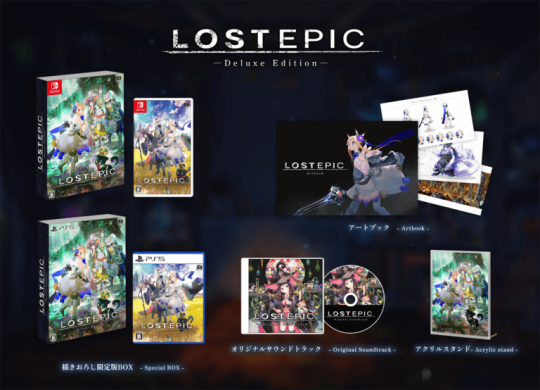
LOST EPIC is currently available digitally for PlayStation 5, PlayStation 4, Switch, and PC via Steam worldwide.
Here is an overview of the game, via One or EIGHT:
About
The latest game from Team EARTH WARS, the creators of the 300,000 DL hit game EARTH’S DAWN.
LOST EPIC is a 2D side-scrolling action RPG about a war between gods and humanity. The player becomes the deity-defying knight, God Slayer, and explores the world known as Sanctum to bring the Pantheon of Six to their knees.
Key Features
Combine Attacks and Divine Skills to Create a Satisfying Combo – Each weapon has its own unique move “Divine Skill.” You can customize your knight by combining your favorite Divine skills. By activating your Divine skill at the right moment, you can take down an enemy and deliver massive damage.
Create Your Own Character Build Using Skill Points – You can further advance the battle by upgrading the character stats according to the weapon you often use. Focusing on specific stats and creating a strength, skill or magic build will also be effective in advancing your quest.
Complete Quests and Earn Rewards – Completing quests given from the many characters will progress the sub-story, and earn rewards for the player. Certain quests require you to fight against enemies known as the Elite. Defeating the Elites can give you powerful rewards.
Craft Items to Better Your Exploration! – When you start to say to yourself, “Where are my medicines?” and “Too many debuffs,” try acquiring materials through cultivating or fishing and craft items! If you find some enemies difficult at times, a good preparation could save you. That is not all, throughout Sanctum, there are hidden items that will surely help you in your venture. Search the corners that tickle your senses and you may find something.
Main Illustrator
Namie – An illustrator from Australia. Has done artwork for Fate/Grand Order, Azur Lane, and Arknights, and character design for The farthest library in the mirror and more.
Voice Cast
The daughter of a Witch, Alta (voiced by Wakana Maruoka)
The Witch of Nabel, Cecilia (voiced by Nanako Mori)
Beautiful and noble Dame of Sanctum (voiced by Marie Miyake)
Son of God (voiced by Ryota Suzuki)
A boy half beast, half human (voiced by Risa Tsumugi)
Ghost Girl (voiced by Amane Shindo)
A girl in hiding through Sanctum (voiced by Airi Ohtsu)
A mysterious black cat (voiced by Fujiya Ichi)
Mariko Higashiuchi
Taro Kiuchi
Honoka Inoue
Casting Corporation AGRS Co., Ltd
Developer
Team EARTH WARS – The production team from EARTH’S DAWN, which was released in 2015 and ported to many platforms. EARTH’S DAWN is a stylish fast-paced 2D action RPG. The user friendly interface and the hack and slash style replayability was praised by hardcore gamers resulting in 300,000 downloads.
Watch a new trailer below.
Physical Edition Trailer
youtube
5 notes
·
View notes
Text
X-DAY
HAPPY 30TH ANNIVERSARY TO X-DAY!!!!!
X-DAY, a game with 3 seperate versions (all lost), released on January 1st 1994, according to this pdf mentioning the games that Namco no longer supported service for as of July 2015. It's a combination of a quiz and fortune game that determines when you will die using your answers to questions and reaction time. This game is much more famous for its thankfully available sequel X-DAY2 and the remix X-DAY2000 in the Taiko No Tatsujin series. Despite the fairly high popularity of 2 and the release of soundtrack CDs for both games, the first X-DAY game remains lost, alongside its Web conversion (while the site is available via Wayback Machine, the game itself is seemingly inaccessible) and i-Mode port (old phone games like this aren't preserved very well generally, Namco had a bunch of these that are now lost). There are no gameplay videos of any version online, as far as I can tell, and I have yet to find actual cabinet photos either...
The X-DAY series is fairly known for its soundtracks, with both 1 and 2 having Namco Game Sound Express CDs, which are both heavily 90s Dance influenced and have a pretty intense sound to them, which seems to throw people off for a fortune game. The first game's in-game music was all done by Ayako Saso, but the arrange tracks on the album were by Ayako Saso, Shinji Hosoe and Nobuyoshi Sano. The second game was seemingly all done by Akihiko Ishikawa, with credits for the previous game's composer and arrangers as multiple songs in 2 were sequenced conversions of 1's arrange tracks. Ishikawa converted the remixes from 1 and also created the new FOX-day and FIX-day tracks.
I've never seen an image of an X-DAY 1 cabinet that isn't the same promotional one, sadly, as it seems most of them were converted into 2 cabinets. If you pay attention to images of X-DAY 2 cabinets, you can see that some look a bit different in their casing, having the physical features of a 1 cabinet. There are very few screenshots and the only ones I have ever found are from official promotional media and the CD. The machine also printed receipts showcasing your results, at least there are plenty of images of those around.



[This post is more focusing on X-DAY1 but just a fun fact about 2: it's actually surprisingly really progressive for a fortune game of the time (1996), featuring the ability to have gay relationships and also even having options for trans players! Funnily enough, relationships get referred to officially by the game as "Super" if one member is trans, and "Ultra" if both members are trans, which explains the song names "FOX-day - Ultra gay edit" and "FOX-day - Super les edit". Another bonus fact, there's a doujin X68000 game based on 1 called Super X-DAY X.]
Also thanks to X-DAY for getting me into this whole obscure arcade thing in general! The music led me down a rabbit hole.
youtube
3 notes
·
View notes
Note
Is there anyway I can help get Louis to #1 in the UK when Iive in the US?
Hi dear,
You can buy the digital album from Louis' store, and put a UK address on the "delivery". Bc it's a digital download, the address won't matter, but it'll count as a UK sale.
You can also promote his album online on social media and try to reach people in the UK. I saw an UA saying to suggest it to people on Omegele could help. That website is a bit sketch so just be safe.
I don't think VPNs work for streaming (I think it might get flagged as bot behavior), so unfortunately that might not be an option. If anyone knows otherwise lmk.
According to Official Charts (the UK charts) this is what they count:
How do you create the charts?
The simple answer is all significant retailers/music services – including iTunes, Amazon, HMV, Google Play, Tesco, Sainsbury’s, Asda, Morrisons, Spotify, Deezer and over 2,600 independent record and video shops. As a result, we estimate that we capture around 99% of all singles sold, 98% of all albums and over 90% of all videos/DVDs.
Do you count downloads?
Yes, of course - we have counted music downloads since 2004, starting within a couple of months of iTunes launching in the UK, when digital music was still a tiny proportion of all music sales.
What about streaming?
Yes, we do. From the July 2014, audio streams started counting towards a chart placing on the Official Singles Chart - and from March 2015, audio streams count towards the Official Artist Albums Chart. To date, the services contributing span Spotify, Deezer, Napster, O2 Tracks (Musicqubed), rara, Rdio, Blinkbox Music and XBox Music.
To reflect the difference between streams and purchases:
100 streams are counted as equivalent to 1 single purchase (whether download, CD or vinyl) and
1,000 streams to 1 album purchase (whether download, CD or vinyl) for chart purposes.
We also count video streams too, but these feed into our industry data services, and do not currently feed into the Official Charts themselves.
More details here and here.
If anyone has additional ideas lmk!!! I wanna help Louis too!!
15 notes
·
View notes
Text
My Fan Autoethnography
For starters, I am currently a fan mostly involved with the Twenty One Pilots (TOP) fan community (some current involvement with Fall Out Boy and Linkin Park, etc.). I interact with posts and follow the band and people related to the band on Instagram and heavily on Twitter/"X". I have a fan account where I post my thoughts about Twenty One Pilots' releases, make and post memes, and talk with fans online. On most nights I listen to "Spaces" on Twitter/"X" where TOP fans speak (like Discord calls) about their love for the band and their music--and about their day, of course. I do not always actually speak in these spaces but I do occasionally if I have time and have the quiet to do so. I mostly interact with fan posts and talk in fan group chats online. I have been a fan ("fanatic?") of this band for 9 years and so far have seen them in concert six times over the years. I plan on seeing them three more times this year in Orlando and in their hometown of Columbus, Ohio (first time doing that). In the past, I had seen them live on two legs of their "Bandito Tour" in 2019, seen them in Atlanta, Georgia on their "Takeover Tour" in 2021, and New York during their "Icy Tour" in 2022. This was due to the fact that they decided to avoid Florida for tours during that entire album cycle... :|
2019 Bandito Tour show #1 outfit after the show! +Drum stick from concert #2!
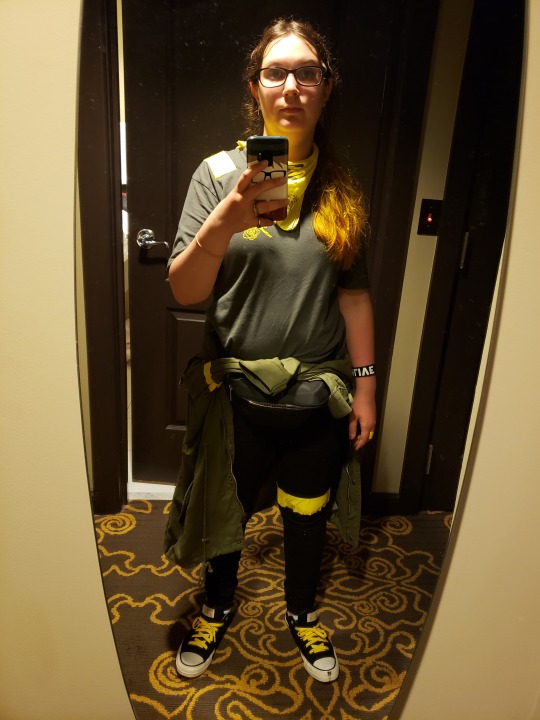

2021 Takeover Tour Atlanta (show #3) preshow photo!
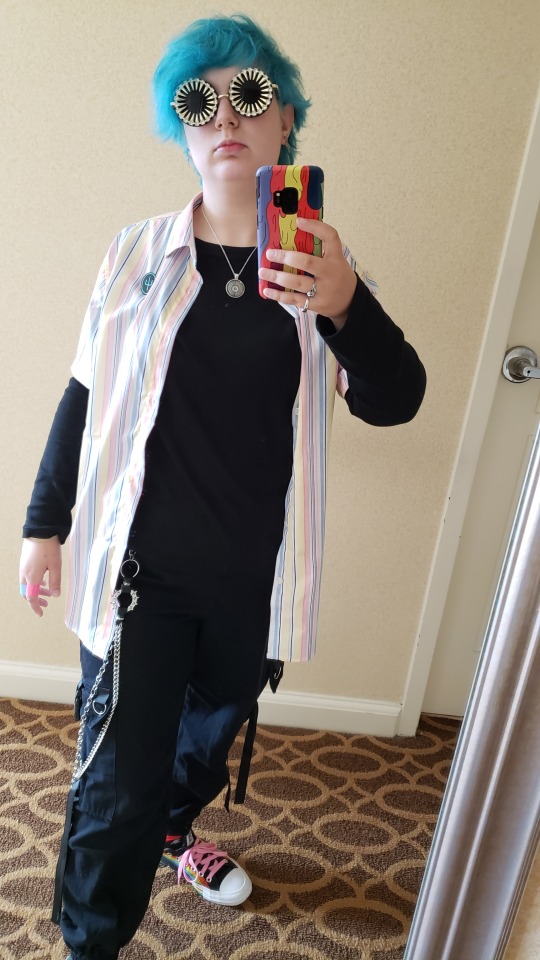
2022 Icy Tour (show #6) photo (closest) at b-stage with Tyler in the background!

I post videos and whatnot from the concerts I go to here:
www.instagram.com/pattyslump
I used to write bits of fanfiction when I was a teenager but I no longer really do that except for a laugh on rare occasion. I do sometimes read fanfiction for enjoyment with other fans. As this band is very lore heavy, I do often watch and read fan theories on social media and YouTube to make sure I understand and I am up-to-date on things. I do 'attempt' to theorize online when I am confident in the implications of a portion of the lore. I rewatch music videos and so on like many of the other fans do to make sure I have picked up on any alternate meanings or lore details that I may not have noticed the first time or four. I connect much of the narrative/lore behind TOP's albums to my own life as they tend to leave room for that.
I have lots of merchandise from TOP (and other bands too!) that consists of about 50 or so T-shirts, all of their albums on CD and most on Vinyl, Funkos, accessories by the band or related to what the band wears, and fanart. I do collect some rarer merchandise like the Blurryface Live vinyl which only had a few hundred copies made when it was first released in 2015. I caught a drumstick during my second time seeing them live. I have collected confetti (referred to as "Trees Confetti" since they always end with that song) from each of the shows I have been to. I have a tattoo that is related to a lyric from a song by TOP and mental health around my wrist. I wholeheartedly believe that if I didn't have this band to cling onto all these years, I would not be here. They definitely were my motivation to get me through my hardships when everything else would get lost. I have a personal attachment to this band as they helped me get through very traumatic moments in my life. Yes, I am one of those fans, deal with it. So, in terms of why people get into fandom and why it means so much to some people, let's just say: I get it.
Analysis questions:
I do believe fandom often has a "us" vs. "them" mentality threaded within it. People identify so dearly to their fandom(s) and the things they like that it does essentially define them as a person or even defines a period of time in their life. As a result of this, fans are very protective as a fandom defines a part of them and their in-group. I have seen this very much upfront in my own fandoms, especially when someone attacks a band or something about them online and everyone is so quick to counter back. Feels like an everyday occurrance we are going after someone who hates on TOP just so they could get more interactions. For me, I have been guilty of doing this at times. Defending. The band and the fans mean so much to me that it feels like I would do anything to prove to someone how great everyone involved is. Unless the band turns out to be bad people then I don't know what I'd do. :|
We all have our biases, I guess...
3. Hoo boy! Anonymity definetly gives fans a confidence that may be hard to find in their daily real lives, I can say that much. This leads fans to post things especially without thought of who is seeing it, this includes TOP and the people that surround the band. People post more explicit artwork, make more offensive jokes, and so forth. People have gotten way too comfortable online. That is, before the lead singer, Tyler Joseph, has started liking posts that talk about him when he is not even tagged in them... people are starting to be a little more careful about what they post. We'll see how long that lasts.
5. As the band TOP loves to make up new words, phrases, and symbols that they fill with meaning, fans eat that stuff up. There are words associated with the narrative behind their most recent albums that can be a code or metaphor for parts of people's lives and their mental health. Due to this, fans that have gone deep enough to learn more about these terms that are very specific to the TOP fandom, these words and symbols can bleed into spaces beyond fandom spaces. For instance, Dema is not a real word (not the meaning put out there when you look it up), represents negative places you want to avoid in your mind and self-sabotaging patterns within your life. The phrase "Sahlo Folina" means nothing except what TOP made it mean, the phrase you call out to those around you when you need help, whether that be needing to talk to a friend or seeking out professional help for mental health difficulties. It's acknowledging the importance of getting help when you know it is best for you--taking that leap. Then, there's also always running jokes from interviews and different videos of the band that are shared between the band and the fans that are hilarious to bring up in daily conversation. So, yeah, I do use these phrases or terms commonly said in the fandom in real life too sometimes. It is also cool when I bring these terms up in conversation and someone I didn't know was a fan makes me aware that they are. It's sick.
0 notes
Text
Digital Media Sources and Sognificance
Blogs
Blog 1:-
Unravelling the Yarn: My Adventures in Narrative Theory and the Tangled Threads of Video Games
I've long wrestled with the captivating conflict between customary account hypothesis and the intuitive stories brought into the world in the pixelated universes of computer games. Will Aristotle's "dramatic unities" of time, spot, and activity, created hundreds of years prior for a static stage, really envelop the rambling, non-direct stories turned by my button squashing and joystick punches? Bordwell and Thompson's (1993) "three core components of narrative" - exposition, complication, and resolution - appear to be unfit to deal with the fanning ways and rising stories encouraged by the player organization. This blog is our encouragement to wander past the recognizable, to investigate the complex accounts of computer games and the exceptional focal points we want to see the value in them.
Customary narratologists frequently end up stumbling over the regulator lines of player organization. They long for the straight directions of books and movies, the solace of a solitary writer moulding the story's curve. However, games love the chaos of interaction. Games like "Dishonored 2" (Arkane Studios, 2016) offer a confounding exhibit of decisions, each impacting the result, however the actual surface of the actual story. Do you kill your objective with merciless proficiency or coordinate a non-deadly takedown, gaining their resenting appreciation? Every way not only uncovers an alternate feature of the story but additionally challenges how we might interpret bravery and ethical quality.
Regardless, to disregard the symphony they play by treating these natural records as inferior cousins is to miss it. Janet Murray (1997), in her stand-out work "Hamlet on the Holodeck," argues that games offer a "participatory literature" where players become co-makers, outlining the story through their decisions and activities. This tendency is reverberated by Espen Aarseth (2003), who centres around the "procedurality" of game accounts, in which the genuine principles of the game make particular stories stand apart from every player's excursion. We're not lethargic eyewitnesses, but rather influential people, squeezing our strings into the record wound around show-stopper.
Take, for instance, the agonizing unfairness in "Firewatch" (Campo Santo, 2016). As well as affecting the result, your decisions in discourse and investigation convey Henry's dejection and frantic state. Alternately, consider the widely circulated "The Witcher 3: Wild Hunt" (CD Projekt Red, 2015), where an innocuous side excursion can enlarge outwards, impacting the fates of domains and, shockingly, forming Geralt's destiny. These games dark the lines between player and record, making us onlookers, yet the very experts driving the story forward.
This isn't to say conventional story devices have no bearing in this maze. Games like "Uncharted 4: A Thief's End" (Naughty Dog, 2016) stunningly mix true-to-life cutscenes with vivid ongoing interaction, creating a convincing person bend for Nathan Drake that matches any blockbuster film. The profound punch of his gathering with Sam, interspersed by stunningly planned interactivity groupings, wouldn't be imaginable without the bedrock of exemplary narrating methods.
Eventually, the magnificence of computer game stories lies in their rebellion of classification. They're a combination of pre-modified universes and player-manufactured encounters, an embroidery woven with strings of written purpose and rising mayhem. To see the value in them completely, we want to embrace this complicated exchange, recognizing the exceptional apparatuses and challenges games present. As Ryan (2004) suitably puts it, "Narratives in games are less about telling and more about doing."
Thus, the following time you boot up your control centre, recall - you're not simply playing a game, you're taking part in a story dance. A dance where each button press, each choice, adds to a story remarkably yours, a story brought into the world from the impact of modified universes and your imaginative flash. In that zapping combination lies the genuine wizardry of computer game accounts.
References:
Aarseth, E. (2003). Computer game worlds: Story, play, and actors. Taylor & Francis.
Bordwell, D., & Thompson, K. (1993). The art of cinematic narration. University of California Press.
Murray, J. H. (2004). Hamlet on the holodeck: The future of narrative in cyberspace. Free Press.
Ryan, J. (2014). Avatars of Story: Narrative Theory for Transmedia Narratives. University of Minnesota Press.
Dishonored 2 (2016). Developed by Arkane Studios. Bethesda Softworks.
Firewatch (2016). Developed by Campo Santo. Panic.
The Witcher 3: Wild Hunt (2015). Developed by CD Projekt Red. CD Projekt S.A.
Uncharted 4: A Thief's End (2016). Developed by Naughty Dog. Sony Interactive Entertainment.
Blog 2:-
Beyond Balance: How Red Dead Redemption 2 Challenges Todorov's Narrative Horse
Red Dead Redemption 2 (Rockstar Games, 2018) spellbound me not simply with its rambling vistas and coarse gunfights, yet in addition with its nuanced story that unobtrusively undermines assumptions. It made me think: how does this advanced magnum opus hit the dance floor with the phantom of Tzvetan Todorov's (1939-2017) account hypothesis, especially his idea of "equilibrium"? Lock in, accomplices, since we're going to unload the story saddlebags of Arthur Morgan and perceive how RDR2 modifies the rulebook.
In Todorov's system, stories follow a natural circular segment: an equilibrium, disrupted by a force, leading to a struggle to restore balance, culminating in a new (though not necessarily positive) equilibrium. While RDR2 begins with Arthur settled in the ideal mayhem of the Van der Linde gang, a similarity to balance, it rapidly dives into the sloppy confusion of a world disintegrating separated. The Pinkertons fix their hold, the law shut in, and the group's inside crevices emit like fountains, breaking any deception of solidness.
Anyway, the strength of RDR2 is its hesitance to permit Arthur to reestablish the past requests comprehensively. This isn't a shoot-em-up where lawbreakers escape towards the skyline and reasonableness wins. Considering everything, the game permits us to see the vexatious breakdown of Arthur's existence, a microcosm of the looming breakdown of the American edges. As Arthur fights his own mortality and the power's downfall into moral haziness, the story's consideration changes into deceitfulness. Its force of scorn and fantasizing is glorious and massively profound.
Consider it like the Dutch's extraordinary plans - elaborate plans considering fickle foundations, bound to fall under the meaning of their own longing. In like manner, the possibility of an unsullied story debilitates as those gaudy dreams disintegrate. Arthur's fight isn't related to restoring plan, yet with finding importance in this continuous reality where the lines between perfect and horrible are on a very basic level generally speaking around as faint as the dusty ways they ride.
This is consistent with Ryan's (2014) discoveries that games give "participatory stories," in which clients assume the job of co-makers and shape the record with their choices. Our moral compass guides Arthur's actions in RDR2, influencing the people he eventually meets, the people he helps, and Arthur himself over time. Due to the weight of these choices, which range from supporting a ruthless land baron to assisting a stranger who is in danger, the narrative arc is further separated from Todorov's straightforward equilibrium-disruption-restoration model.
RDR2 doesn't offer a cheerful closure, a restored equilibrium, or an obvious triumph. All things being equal, it waits in the clashing uncertainty of Arthur's last minutes, passing on us to consider the expense of steadfastness, the heaviness of recovery, and the transitory idea of equilibrium in a world tearing towards disarray. This open-endedness repeats Aarseth's (2003) idea of "procedurality" in-game accounts, where the actual guidelines of the game - for this situation, the ethical decisions and eccentric world - produce emanant stories special to every player.
At last, Red Dead Redemption 2 stands as a demonstration of the developing scenes of narrating. It embraces the intelligent idea of games, the muddled intricacy of human decisions, and the ambivalent real factors of a steadily influencing world. An account work of art doesn't simply follow Todorov's pony, it rides close by it, wandering off in an unexpected direction and investigating the wild outskirts of a story where equilibrium is a momentary dream and the genuine excursion lies in exploring the greyest of moral scenes.
In this way, accomplices, the following time you saddle up in RDR2, recall - that you're not simply playing a game, you're partaking in story unrest. a revolution that breaks the old rules and embraces the new, leaving you to ponder the gunshot echoes and fading whispers of a world that has changed forever.
References:
Aarseth, E. (2003). Computer game worlds: Story, play, and actors. Taylor & Francis.
Ryan, J. (2014). Avatars of Story: Narrative Theory for Transmedia Narratives. University of Minnesota Press.
Todorov, T. (1969). Poetics of prose. Cornell University Press.
Rockstar Games. (2018). Red Dead Redemption 2. [Video game]. Rockstar Games.
Blog 3:-
Beyond Bullets and Booms: Navigating the Murky Waters of Realism in Video Games
With war games, realism is the big issue that I've always struggled with. Titles like Battlefield V (EA DICE, 2018) and Call of Duty: World War II (Sledgehammer Games, 2017) guarantee vivid encounters, moving players to the sloppy channels and slug-zooming combat zones of history's most obscure contentions. In any case, how "real" could these advanced universes at any point really be? And is it even desirable to achieve perfect realism? Soldiers, buckle up because we are about to enter the murky world of video game realism and find out if what we discover is real history or just pixelated dust.
We ought to start by perceiving the undeniable: war is horrible, savage, and jumbled. In games like Battlefield V, the visceral depictions of close-quarters combat and the gut-wrenching cries of the wounded do not shy away from this darkness. In any case, validness isn't just about reproducing blood and grime. It's about depiction, getting what is going on, the climate, and the human cost of the dispute. This is where games like Call of Duty: WW2, which told the stories of traditional soldiers caught in the whirlwind of war, taught us that bravery and misfortune coexist in the brutal reality of war.
In any case, here's the rub: " reality" is abstract. Games always have their historical accuracy filtered through the developers' eyes. This, as per Ryan (2001), is the realm of simulation, where the game world mimics reality but isn't a perfect carbon copy. This isn't an imperfection, yet a component. Games can feature explicit parts of contention, zeroing in on brotherhood, the mental cost of war, or the moral quandaries looked at by troopers - angles frequently minimized in customary verifiable accounts.
In any case, this carries us to the concept of immediacy: the illusion of being "there" on the battlefield. Games influence general media innovation to create a substantial feeling of presence, the roaring blasts, the sting of shrapnel, and the terrified yells of individual troopers. This is where the lines between portrayal and reality obscure, making a strong hypermediacy (Murray, 1997), where the experience rises above the actual game and leaves an emotional imprint.
Be that as it may, could this hypermediacy at any point wander into hyperreality, where the pixelated world obscurations the authentic truth of war? Some contend that zeroing in on the instinctive rushes of battle chances extolling war or limiting its intricacies. This is where game engineers face a basic obligation: to offset vivid ongoing interaction with verifiable precision and moral mindfulness.
Eventually, the quest for ideal authenticity in computer games is a waste of time. All things considered, we ought to zero in on experiential realism: catching the substance of war, its personal weight, and its human expense. Games like This War of Mine (11 bit studios, 2014) or Valiant Hearts: The Great War (Ubisoft Montpellier, 2014) accomplish this perfectly, driving players to face the ethical ambiguities and regular citizen difficulties frequently missing in conventional conflict stories.
In this way, the following time you tie on your virtual boots and protective cap, recollect - computer games offer a significant focal point through which to investigate the war, however, that focal point is intrinsically bent. Embrace the force of hypermediacy to feel the heaviness of history, however, remain basic, mindful of the designer's decisions and the moral ramifications of playing battle in a pixelated world.
References:
Murray, J. H. (1997). Hamlet on the holodeck: The future of narrative in cyberspace. Free Press.
Ryan, J. (2001). Narrative as virtual reality: Immersion and interactivity in literature and electronic media. Johns Hopkins University Press.
Battlefield V. Electronic Arts Dice. (2018). Battlefield V. [Video game].
Call of Duty: World War II. Sledgehammer Games. (2017). Call of Duty: World War II. [Video game].
Blog 4:-
Beyond Buttons and Booms: Demystifying Meaning in Video Games with Semiotics
As a both player pixel-based undertakings and philosophical reasoning, I have forever been entranced by computer games' strange language. What certified importance can be found in these complex universes stacked up with unconventional creatures and pixelated scenes? Research the entrancing investigation of pictures and signs in the field of semiotics. We're going to set out determined to utilize semiotics to figure out the code of computer game stories, leaving no pixel unturned, so lock in, individual travellers!
Our aide on this excursion is the incredible Charles Sanders Peirce (1839-1914), who laid the foundation for grasping signs. He sets three key types: symbolic, where a sign's importance is inconsistent still up in the air(think the heart symbol for love); iconic, in which the sign resembles its symbol(a traffic cone pointing to roadwork); furthermore, indexical, where the sign has a direct actual association with its referent (smoke indicating fire).
Could we take, for example, the humble mushroom in The Legend of Zelda: Breath of the Wild (Nintendo, 2017). Depending on its size and variety, this seemingly harmless item can be a tasty bite, a potent mixture fixing, or even a lethal toxin. By separating these mushrooms according to Peirce's point of view, we see how their representative worth (well-being support, crafting material, risk) is gone through their famous appearance (size, variety) and indexical properties (sparkling for embellishments). Each mushroom transforms into a little language structure, mumbling its inspiration to the discerning player.
Regardless, significance isn't just about individual signs; it's also about how they partner and team up. This is where made by Claude Levi-Strauss, with his syntagmatic and paradigmatic analysis, turns out to be useful. The syntagmatic analysis sees how signs join to shape plans and developments, like the deals for things in a making recipe or the improvement of events in an excursion. The paradigmatic analysis, then again, sees how signs associate with each other through substitution and separation. For example, picking either a sword and a bow for the fight to come or contrasting serene towns with jails tormented by monsters are instances of paradigmatic models.
Consider the famous Mario platformer (Nintendo, various years). The succession of mushrooms, coins, and Goombas in each level structures a syntagmatic design, a mini-narrative with a test and prize. Yet, the player can pick various ways, subbing one enhancer for another, and making a paradigmatic encounter. Utilizing a similar arrangement of building blocks, this exchange of syntagms and paradigms makes a powerful embroidery of implying that makes each playthrough one of a kind.
Naturally, semiotics is not without its difficulties. Computer games are perplexing embroidered works of art of visuals, sounds, mechanics, and player organization, making it hard to nail down a solitary, conclusive understanding. In any case, the semiotic focal point gives an important device for unloading the layered messages and unobtrusive implications implanted inside these computerized universes.
In this way, the following time you fire up your favourite game, recollect that you are participating in a dynamic discourse about images and pictures as well as basically playing. Focus on the little subtleties, for example, the ambient sound or an individual's clothing colour. The jigsaw is made up of pieces that can be seen and understood by anyone.
References:
Barthes, R. (1977). Image-music-text. Fontana.
Fiske, J. (1990). Television culture. Routledge.
Ryan, J. (2014). Avatars of Story: Narrative Theory for Transmedia Narratives. University of Minnesota Press.
Nintendo EPD (2017) Legend of Zelda: Breath of the Wild [Video Game]. Nintendo.
Nintendo. (1985). Super Mario Bros. [Video game]. Nintendo.
Blog 5:-
Beyond Pixels and Polygon Counts: Deconstructing Visual Identity in Games
As a gamer who has an intense feeling of touch and a craving to grasp how we see ourselves, I've forever been excited by the force of visuals and in-game frivolity characters. We make images that mirror our personalities and goals by emulating these modernized universes, as opposed to just existing in them. Be that as it may, how do the pixels and polygons on our screens come to shape our healthy identity? Now is the right time to get our amplifying glasses and dive into the domain of visual culture and character in games, leaving no pixel unturned!
We should begin with the unrefined substances: representation. The characters, scenes, and items we experience in games are painstakingly developed visual accounts, loaded down with social implications and suspicions. From the hyper-masculine warriors of God of War (Sony Interactive Entertainment, 2018) to the splendidly hued fashionistas of Animal Crossing: New Horizons (Nintendo, 2020), each visual component says a lot about what our identity is supposed to be, who holds power, and what standards are thought of "normal."
In any case, these portrayals aren't vacant shells; they really help to frame our refined character. We select their garments, hairdos, and, surprisingly, actual changes as we investigate these unrivalled universes, making an exhibition of photographs that develop into expansions of our identity is. Crawford (2009) contends that this presentation of decision turns into a kind of "self-fashioning," permitting us to try different things with numerous forms of ourselves and challenge or support customary assumptions.
This, in any case, goes with its requirements. Games frequently work inside thin scopic systems (Crary, 1992), privileging explicit approaches to seeing and collaborating with the world. The "oculocentric" centre around vision in many games (Murray, 2004) can underestimate different faculties and support existing power structures. For instance, the hyper-sexualized portrayals of female characters in many games can propagate unsafe generalizations and cut off player organization in creating different personalities.
Be that as it may, there's in like manner space for oppositional aesthetics (hooks, 1990) - a way to deal with recuperating and controlling visual metaphors to subvert winning stories. Games like Gone Home (The Fullbright Company, 2013) or Night in the Woods (Infinite Fall, 2017) offer choice scopic frameworks, allowing players to explore character complexities past spread out principles, whether through LGBTQ+ depiction or nuanced portrayals of profound prosperity.
At long last, the visual scene of games isn't simply a stunning setting; We build, dismantle, and rethink our sound character in this exceptional wilderness rec center. As we continue, we should challenge prohibitive scopic systems, commend the rebellious capability of games to expand visual character prospects, and basically inspect the gave portrayals.
References:
Crawford, M. (2009). How videogames are changing the way we live, think, and relate. Norton.
Crary, J. (1992). Techniques of the observer: On vision and modernity in the nineteenth century. MIT Press.
hooks, b. (1990). Yearning: Race, gender, and cultural politics. Routledge.
Murray, J. H. (2004). Hamlet on the holodeck: The future of narrative in cyberspace. Free Press.
In Harvard referencing, video game titles are formatted differently depending on whether you're referencing the whole game or a specific element within it. Here's how to convert the two game titles you provided:
God of War (Santa Monica Studio, 2018). [Videogame] Sony Interactive Entertainment.
Animal Crossing: New Horizons (Nintendo EPD & 1-Up, 2020). [Videogame] Nintendo.
Gone Home: The Fullbright Company. (2013). Gone Home [Video Game]. PC.
Night in the Woods: Infinite Fall. (2017). Night in the Woods [Video Game]. PC, PlayStation 4, Xbox One.
Blog 6:-
Beyond Pixels and Power-Ups: Unpacking Politics, Diversity, and Identity in Games
I've long felt the thunder of legislative issues underneath the outer layer of even the most dreamer virtual universes. Games, similar to any social item, are not unbiased jungle gyms; they're woven with belief systems, predispositions, and portrayals that address genuine power elements and characters. Today, we're airing out this computerized Pandora's crate to investigate how games draw in with politics, diversity, inclusion, and the complex landscapes of race and gender. Lock in, individual explorers, in light of the fact that the journey for a more impartial and enhancing gaming scene begins here!
How about we start by recognizing the glaring issue at hand: representation matters. From the hyper-manly champions of Call of Duty (Activision, various years) to the hyper-sexualized female characters in numerous RPGs, games frequently sustain destructive generalizations and cut player organization in making assorted personalities. This absence of portrayal, as Nakamura (2008) contends, can build up true imbalances and bar minimized bunches from completely partaking in the gaming circle.
In any case, in the midst of this haziness, there are traces of trust. A few games, like Gone Home (The Fullbright Company, 2013) and Night in the Woods (Infinite Fall, 2017), give complex portrayals of LGBTQ+ communications, while What Remains of Edith Finch (Giant Sparrow, 2017) digs profoundly and mindfully into the subject of close to home wellbeing. As Alexander (2015) brings up, these games undermine the tried and true way of thinking and prepare for additional careful and convincing portrayals.
However, diversity is more than just ticking boxes; it's about inclusion. How are these diverse characters integrated into the narrative? Is it true that they are consigned to token companions or do they drive the story forward? Do their encounters widen how we might interpret the game's reality, or would they say they are basically window-dressing? Games like Disco Elysium (ZA/UM, 2019), with its different cast and player organization over character decisions, offer a brief look into a comprehensive future where player personality crosses definitively with the game's reality.
Notwithstanding, we can't overlook the insidious power of power structures. Games frequently reflect and support genuine disparities, portraying imperialism, double-dealing, and fundamental persecution in manners that can be coldhearted or even manipulative. This, as de Castilho (2019) cautions, can minimize complex policy-centered issues and propagate unsafe accounts. Assassin's Creed: Unity (Ubisoft, 2014), with its generally wrong depiction of the French Upheaval, act as a wake-up call, helping us to remember the requirement for basic commitment to the political belief systems implanted inside game universes.
At last, we should go up against the prickly issue of race and orientation. How do these developed social classifications shape our encounters in games? How really do game mechanics and stories build-up or challenge existing predispositions? Critical Race Theory, as applied by Hooks (2015) and others, offers an important focal point for looking at how games sustain racial generalizations and could work as stages for perceived hostilities against players of variety. Also, women's activist scrutinizes, as expressed by Consalvo (2010), feature the gendered suppositions and mechanics that can estrange or typify female players.
The excursion towards a more fair and enhancing gaming scene is a complicated and progressing one. By basically inspecting the governmental issues, variety, and character legislative issues installed inside games, we can turn out to be more dependable players, designers, and pundits.
References:
Alexander, L. (2015). Gamergate and the crisis of video game criticism. MIT Press.
Consalvo, M. (2010). Challenging gender norms in video games: From Mario to Lara Croft. Routledge.
de Castilho, R. (2019). Gaming politics: How video games play news and power. Oxford University Press.
hooks, b. (2015). Black skin, white masks. Routledge.
Nakamura, L. (2008). Don't just stand there... Dance!: Racializing space and identity in videogames. Johns Hopkins University Press.
Gone Home: The Fullbright Company. (2013). Gone Home [Video Game]. PC.
Activision. (2019). Call of Duty: Modern Warfare [Video Game]. PlayStation 4.
Night in the Woods: Infinite Fall. (2017). Night in the Woods [Video Game]. PC, PlayStation 4, Xbox One.
What Remains of Edith Finch: Giant Sparrow. (2017). What Remains of Edith Finch [Video Game]. PC, PlayStation 4, Xbox One.
Disco Elysium: ZA/UM. (2019). Disco Elysium [Video Game]. PC.
Assassin's Creed: Unity: Ubisoft. (2014). Assassin's Creed: Unity [Video Game]. PlayStation 4, Xbox One.
Blog 7:-
A Gunshot to the Gut: Immersing in the Gritty Emotionality of Mafia 2
I'm drawn to stories that have a big emotional impact on me as a player., My emotions were hit like a Molotov cocktail by Mafia 2 (2K Games, 2010). From the messy roads of Empire Bay to the melancholic piano harmonies reverberating through smoky speakeasies, the game wasn't simply a digital playground; It was a visceral experience that changed the way I thought about how emotionally invested people are in video games. In this way, individual wiseguys, get your tommy guns and your handkerchiefs, since we're going to plunge into the close to home maze of Mafia 2.
Let's start with Massumi (2008) idea of the raw power of affect, which says that emotions are not just internal states but embodied intensities that run through our being. Vito Scaletta, a young Italian-American caught in the web of organized crime, is the protagonist of the game. The clunking of glasses in private cabin bargains, the adrenaline surge of avoiding disasters in a Submachine gun fight, the bone-squashing effect of treachery - these aren't just visual or hear-able boosts; They are real experiences that make your heart race and make your palms sweaty. Mafia 2 doesn't simply recount to you a story; You get a gut feeling of it.
Yet, influence alone isn't sufficient. To really charm, a game requirements another viewpoint, as Ryan (2010) contends. Mafia 2 doesn't offer the romanticized perspective on the hoodlum life so frequently glamorized in mainstream society. All things being equal, it dives you into the ethical entanglement, constraining you to observe the mercilessness, the disloyalties, and the empty shells of men consumed by covetousness and neurosis. This change in context, this awkward closeness with the clouded side of the Pursuit of happiness, makes a remarkable profound mixed drink - a mix of elation, repugnance, and a biting feeling of disquiet that waits long after the credits roll.
The music, on the other hand, is the lifeblood of Mafia 2's emotional landscape. The score, a masterful fusion of jazz and blues, is more than just noise in the background; it's a person in itself. The despairing kinds of "Lonely Woman" saturate the smoky climate of a bar, reflecting Vito's segregation and longing for a daily existence past the horde. The sporty piano riffs during vehicle pursues uplift the elation of the departure, while the forlorn trumpet performances going with burial services highlight the expense of a day to day existence interweaved with brutality. Mafia 2, as Perron (2013) calls attention to, utilizes music to lay everything out, except to control our feelings, directing us through the emotional rollercoaster of Vito's excursion.
At last, Mafia 2's emotional commitment lies in its tasteful delight (Carroll, 2001). The game doesn't just engage; it makes a lovely, though disastrous, world that attracts you and makes you care profoundly about its characters and their destinies. The painstakingly created climate, the nuanced exhibitions, the music that grips to your spirit - they all work together to make an encounter that rises above pixels and polygons, leaving you with a waiting feeling of despairing, reflection, and maybe even a bit of wonderment for the force of a very much recounted story to move us so profoundly.
Thus, the following time you boot up Mafia 2, recollect - it's not only a game; it's a personal odyssey. Focus on the subtleties, from the gleaming gaslights to the fatigued looks on the characters' countenances. Allow the music to wash over you, feel the mood of the city beat in your veins. Mafia 2 is an update that computer games, at their best, can offer something other than rushes and spills; they can cause us to feel the full range of human experience, leaving us changed and perpetually set apart by the reverberations of gunfire and the mixed notes of a blues melody.
References:
Carroll, N. (2001). Art, beauty, and the future of aesthetics. Cornell University Press.
Massumi, B. (2008). What affects can do: Philosophical essays. Duke University Press.
Perron, B. (2013). Playing to feel: A theory of ludic affect. MIT Press.
Ryan, J. L. (2010). Narrative as virtual reality: Immersion and interactivity in literature and electronic media.
2K Games. (2010). Mafia II. 2K.
Blog 8:-
A Dance with the Void: Embracing the Uncomfortable Depths of Dishonored's Emotionality
Dishonored (Arkane Studios, 2012) wasn't simply a game; it was a drop into an ethically uncertain void that left me wrestling with awkward feelings long after the credits rolled. It wasn't the raw power of supernatural abilities or the visceral terror of stealth missions that truly resonated; it was an inconspicuous, disrupting cacophony, a steady murmur of scrutinizing that bothered my heart. Thus, individual voidwalkers, get ready for an exciting mixture of effect, stylish disquiet, and new points of view, since we're going to unwind the profound maze that is Dishonored.
The game tosses you into the shoes of Corvo Attano, a shamed protector push into a universe of political deaths and extraordinary powers. From the plague-ridden roads of Dunwall to the extravagant, choking out bounds of the Brilliant City, the actual environment throbs with influence, as Massumi (2008) portrays it. The squeaking woods of deserted houses, the throaty moans of plague casualties, the eerie murmurs of the Void - these aren't just hear-able signs; They are sensations that are embodied and seep into your skin, causing a constant feeling of tension and unease. Dishonored doesn't besiege you with obvious profound triggers; it develops an inescapable climate of moral vagueness, compelling you to stand up to the inconvenience of exploring a world without clear legends and miscreants.
In any case, this disquiet isn't simply a dormant experience; Ryan (2010) asserts that it is a deliberate shift in context. You are not a typical legend wielding a weapon and maneuvering through hordes of enemies. The viability of Corvo's powers is captivating, however they accompany a cost. Each squint through time, each responsibility for body, chips away at your humankind, leaving you faltering close the actual edge of the beast. Dishonored does not shield you from the consequences of your actions; It compels you to observe the profound cost of employing such power, the weakening of sympathy, and the plummet into distrustfulness that accompanies controlling life itself.
What's more, subsequently, there's the music, a melancholic three-step dance among greatness and decay. Daniel Licht's score doesn't offer triumphant songs or blood-siphoning calls to war; Reflecting the decay of the city and Corvo's internal turmoil, it is an embroidery of melancholy strings and piercing murmurs. A substantial sign of the human expense of upset and the scars left by viciousness, the despairing hold back of "Streets of Dunwall" keeps on playing long after the credits roll. According to Perron (2013), Shamed uses music to set the mood, but it also increases moral and emotional ambiguity, leaving you with a waiting sense of unease and reflection on the cost of reclamation.
Eventually, Dishonored's commitment lies in its tasteful joy (Carroll, 2001), however, it's a wound, awkward joy. The game doesn't offer idealism or therapy; it drives you to defy the offensiveness inside yourself and your general surroundings. It's a hit the dance floor with the void, a three-step dance through moral ill-defined situations, an orchestra of discord that waits long after the last reverberates of Dishonored's chilling decision.
Thus, the following time you dig into the profundities of Dunwall, recall - this isn't a power dream; it's a mirror held up to your soul. Focus on the unobtrusive subtleties, how shadows dance on disintegrating walls, and the flash of vulnerability in Corvo's eyes. Feel the weight of the decisions you've made and the challenges you've faced as the music penetrates your soul. Shamed is an update that computer games, at their thinking for even a second to best, can cause us to feel the full range of human experience, even the awkward pieces, leaving us everlastingly different by the shadows we find inside ourselves.
References:
Carroll, N. (2001). Art, beauty, and the future of aesthetics. Cornell University Press.
Massumi, B. (2008). What affects can do: Philosophical essays. Duke University Press.
Perron, B. (2013). Playing to feel: A theory of ludic affect. MIT Press.
Ryan, J. L. (2010). **Narrative as virtual reality: Immersion and interaction
Arkane Studios. (2012). Dishonored. Bethesda Softworks.
Blog 9:-
Beyond Buttons and Bosses: Exploring Intertextuality and Transmedia in the Video Game Universe
I've forever been captivated by how computer games play with intertextuality and transmedia narrating as a gamer who appreciates stories that weave mind-boggling networks across different media. From subtle motions to imaginative beasts in The Witcher 3: Wild Hunt (CD Projekt Red, 2015) to the meandering aimlessly transmedia space of Overwatch (Blizzard Entertainment, 2016), games are not commonly restricted islands; their enthusiastic focus focuses interconnected with weaving of references and stories. Utilizing the hypothetical systems of structuralism, poststructuralism, extremist intertextuality, and multimodality, we are diving into this entrancing field today to find the associations between games and the more extensive social scene.
We should start with the central idea: intertextuality. As Kristeva (1967) contends, no text exists in a vacuum. Each story draws upon, rethinks, and undermines previous works, making a trap of interconnections that improve the understanding experience. Games are no exemption. The Witcher 3, for example, is filled with implications to Arthurian legend, from Geralt's chivalric code to the Woman of the Lake's puzzling presence. These references, as Jenkins (2006) notes, flash an exchange among games and different media, welcoming players to become dynamic members in translating and reevaluating meaning.
Regardless, intertextuality gets impressively more empowering when it embraces multimodality. To recount their accounts, games use visuals, sound, ongoing interaction mechanics, and even player offices. Contemplate Bioshock Infinite (Irrational Games, 2013). The floating city of Columbia doesn't just reference Yankee fables and optimistic norms; It exemplifies them with its transcendent engineering, taking-off aircraft, and enthusiastic residents. Investigation and battle that oppose gravity further submerge you in Columbia's particular world, obscuring the line between text and experience.
Transmedia describing takes this blending of texts to an unfathomable level. Foundations like Overwatch, as Henry Jenkins (2007) raises, expand their records past the genuine game, twisting around stories through comics, spiced-up shorts, and, shockingly, in-universe news reports. Subsequently, the line between shopper and maker is obscured in a transmedia world where players effectively add to the creation and development of the legend. The Overwatch social class' energetic fan craftsmanship, cosplay, and, shockingly, vicious esports scene exemplify this agreeable story improvement.
In any case, a central centre is expected to investigate these intertextual and transmedia labyrinths. Garrety (2007) proposes progressive intertextuality, which prompts us to ask about who controls the significance-making process in these amazing stories. How do players participate in transmedia storytelling and interpret references? Do players have agency? Or on the other hand, would they say they are restricted by the pre-decided stories set by designers and partnerships?
Intertextuality and transmedia in games are eventually engaging because they can undermine ordinary thoughts regarding creation and portrayal. They empower us to become dynamic members in a more extensive talk by laying out joins, changing around references, and in any event, describing mutually delivered stories. Hence, the accompanying time you boot up your main game, centre around the mumbles of various stories inside its world, explore the transmedia climate including it, and recall - you're not just playing a game; you're adding to an enthusiastic, reliable creating weaving of shared experiences.
References:
Garrety, K. (2007). Radical intertextuality: The transformative potential of citation. Palgrave Macmillan.
Jenkins, H. (2006). Convergence culture: Where old and new media collide. NYU Press.
Jenkins, H. (2007). Transmedia storytelling: Imagining and building transmedia worlds. The Journal of Media Education, 41(4), 133-142.
Kristeva, J. (1967). Word, dialogue, and novel. Fordham University Press.
CD Projekt Red. (2015) The Witcher Wild Hunt [Video Game]. CD Projekt Red.
Blizzard Entertainment. (2016) Overwatch [Video Game]. Blizzard Entertainment.
Irrational Games. (2013) Bioshock Infinite [Video Game]. 2K Games.
Blog 10:-
Shifting Gears: Gran Turismo 7 and the Evolving Landscape of VR, AR, and MR
Having completed my share of virtual miles as an experienced racer, Gran Turismo 7 (Polyphony Digital, 2022) conveyed something beyond a new layer of paint on exemplary circuits. It filled in as a brief look into the eventual fate of hustling games, one where the lines between the real world and reenactment obscure further because of rising innovations like Virtual Reality (VR), Augmented Reality (AR), and Mixed Reality (MR). Today, we're locking in and taking a hypothetical refuelling break to investigate how Gran Turismo 7 and its possible hug of these advances can rethink how we might interpret interactivity, immersion, and the actual idea of the dashing experience.
Interactivity, long the foundation of computer games, takes on another aspect in VR. Envision venturing into the driver's seat, feeling the sun warm your advanced hands as you grasp the virtual guiding wheel. Gran Turismo 7, with its fastidious vehicle models and laser-examined tracks, as of now lays the foundation for an instinctive VR experience. In any case, as Ryan (2010) contends, genuine intuitiveness goes past imitating actual activities; it's tied in with fashioning a profound association with the virtual world. VR, whenever executed mindfully, could cause us really to feel like we're essential for the race, the thunder of the motor a heartbeat in our ears, the g-powers an actual sensation.
In any case, drenching isn't just about tangible loyalty. According to Baudrillard (1994), it is about extension, which blurs the lines between reality and representation. Envision checking tire tension in a virtual pit path or changing mirrors with a flick of your wrist. AR overlays could improve track mindfulness, showing hustling lines or contender positions progressively, obscuring the limit between driver and machine. This consistent mix of physical and virtual components, as Azuma (1997) places, could rethink the actual idea of a dashing game, changing it into a cross-breed preparing ground and virtual circuit.
Naturally, with advancement comes the possibility of becoming obsolete. Customary regulators and level screens, when the main entries to dashing universes, could feel artifact-like notwithstanding vivid VR encounters. Be that as it may, rather than grieving the past, we should consider it to be a development. As Crawford (2009) reminds us, games are not static mediums; they adjust and change close by innovation. Gran Turismo 7, with its potential VR and AR executions, offers a brief look into this development, preparing for a future where the experience of hustling rises above pixels and polygons, turning out to be nearer and nearer to the genuine article.
Be that as it may, this advancement isn't without its difficulties. VR, for example, raises issues of openness and inclusivity. Many people are physically uncomfortable in virtual reality environments or unable to afford expensive VR headsets. According to Bardini (2012), retrieval is just as important as innovation as we race toward an immersive racing future. Developers must ensure that no one is left behind on the starting grid in the future of racing by utilizing traditional controllers and flat screens, which still provide valuable access points for a wider audience.
Last but not least, there is always the possibility of reversal. VR, while vivid, can disengage players from the actual world. We are brought back to the social aspect of racing by Gran Turismo 7, with its extensive car culture and online communities. MR, with its capacity to mix the virtual and genuine, could offer the smartest possible scenario - thrilling VR races accentuated by imparted festivities to companions in the front room. This exchange among disconnection and association, as boyd (2014) contends, will be urgent in molding the fate of hustling games, guaranteeing they give individual rushes as well as encourage a feeling of shared local area.
Along these lines, lock in, individual petrolheads! Gran Turismo 7 is something beyond a dashing game; it's a harbinger of a future where VR, AR, and MR change how we experience the excitement of the circuit.
References:
Azuma, R. T. (1997). Re-engineering Reality: Towards a More Powerful Tool for Human-Computer Interaction (Doctoral dissertation, Massachusetts Institute of Technology).
Bardini, E. (2012). Game culture: A new approach to cultural studies. Springer.
Baudrillard, J. (1994). Simulacra and simulation. University of Michigan Press.
boyd, d. (2014). **It's complicated: The social lives of networked teens
Polyphony Digital. (2022). Gran Turismo 7. Sony Interactive Entertainment.
0 notes
Text
Into, Across and Beyond! Cast: CD Alt End Sonic
Replaces: Ezekiel Sims / Spider-Therapist
Origin: Sonic CD Alternative Ending by Lucsan 2015

"I lost my Tails and Amy, and the happy land I once inhabited... I refuse to let any more innocent souls knowingly die because of me!"
The tale of Little Planet, a rather unique journey amongst Sonic's many. Time travel, his first meeting with Amy Rose, a small planet chained over a lake... it's all pretty much there. Many Sonics have faced this on, and the usual worst possible outcome is just Robotnik escaping with one of the Time Stones, but that's easily thwarted.
However, not all Sonics got off as lucky as this. This Sonic in particular hails from a much more horrible conclusion to the tale. While he didn't give the entire planet a good future, Sonic still managed to defeat the doctor and escape his crumbling fortress. However, that's where the similarities end.
The resulting explosion from Metallic Madness, which occurred after Sonic was back on solid ground without Amy, who he thought had escaped, caused Little Planet's orbit to be knocked out of focus, which set off a deadly crash course with the lake. Sonic hightailed it the heck out of there as many critters ran to try and find shelter or escape.
The impact wiped out a LOT of life within the surrounding area and close to South Island, and Sonic felt awful that he couldn't be there for them. He navigated the labyrinths under Never Lake and the fields outside the area, and was disheartened that even the flowers couldn't last long in the ruined conditions.
He returned to Little Planet's remains after the Tornado crashed, and was forced to watch as a surviving Flicky got crushed under some unstable rubble in the Metallic Madness wreckage. However, what Sonic saw VERY shortly after almost brought him to his breaking point.
The corpses of both Tails and Amy, both having failed to escape the crash. Sonic could NOT take it anymore, yelling in sorrow to the heavens and sobbing uncontrollably from his losses, and all because he couldn't stop Little Planet's crash. At this point, he was borderline suicidal, rushing off out of Never Lake's reach as fast as he could.
A strange crystal he picked up prior, though, got the attention of this universe's Knuckles, who arrived at the remains as soon as he could. He followed the trail Sonic left behind, even coming across Robotnik's corpse in Scrap Brain, which was spin-dashed through by Sonic.
The only good news Knuckles had was that there were survivors, and that the blood trail left behind could let him get after Sonic, who was extremely close to ending his life via a pit of spikes. Fortunately, Knuckles glided right through and caught Sonic, bringing him to safety and offering a hand to hold in his troubling times.
However, Sonic was having painful hallucinations, causing him to turn tail in panic. Once he ran far enough, though, he saw a non-creepy Amy and Tails in front of him; namely, their spirits, who were encouraging him to move on and continue to grow as a person. Sonic struggled with the thought, though tearfully accepted.
From then on, Sonic (now dubbed "CD!Sonic") made a promise; he would NEVER knowingly let another life perish due to inaction or mistakes. As such, he helped the surviving critters leave Scrap Brain after the storm subsided, and scoured the globe helping stop other disasters from hurting innocent people.
He was later found by EV!Sonic and Tekno, his experience being admired for his growth as a person, and was recruited as a member of the Quill Society, his role being to help any other heroes going through their own grief with support and understanding, his own experiences helping with that.
He was more than happy to extend comfort to anyone in need, and he received support back for it. In fact, one of the big reasons on his part for refusing to abide by LM!Sonic's canon event theory is the risk of being overworked by too many future recruits suffering losses. As such, he was out on a break at the time of the big chase across Gust Planet, and was glad the theory was debunked in the end.
As you can kinda tell from his sprites, the blood on his fur had dried in, and he wasn't able to wash it off at all by the time he noticed. That said, it still worked as a way to identify him amidst the other Sonics in the multiverse.
0 notes
Text


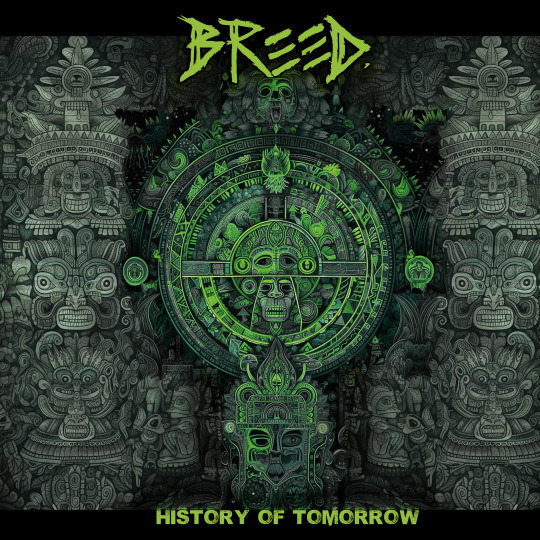
Furious determination
Action: BREED
Title: History Of Tomorrow
Base: Osnabrück • Germany
Style: Thrash Metal
Genre: Classic Thrash Metal, Power Thrash Metal
FFO: Forbidden, Overkill, Exodus
Type: Full-length
Format: CD + Vinyl
Label: Doc Gator Records
Release: Dec. 15, 2023
BREED are available for interviews via phone, Skype, Zoom & email
Bulletpoints:
🔘 The debut album of the experienced Metallers
🔘 Explosive outbursts, confidently played
🔘 Efficiently coherent old/new school mix
PR:
METAL MESSAGE ᴳᴸᴼᴮᴬᴸ • 𝓔𝓼𝓽. 2001
https://www.metalmessage.de/PR_BREED_en.php
FB:
https://www.facebook.com/BREEDmetal/
https://youtu.be/S63mioWSeBI
[ In Your Face • Official Music Video ]
BREED says about the song:
„‚In Your Face‘ is a good reflection of the upcoming album ‚History Of Tomorrow‘, which will be released on December 15, 2023. It’s a tribute to the golden days of the 90s, when Thrash Metal was more than a genre. It was a way of life. Even today … at least for us. Socially critical, never conforming and rejecting the mainstream. Musically, ‚In Your Face‘ taps into the Bay Area genre, but still manages to show our independent style. ‚In Your Face‘ is about our own perception of the present day – egocentric actions, monetarily influenced and always prioritising one’s own advantage. ‚The tongue is my fist!‘: this lyric exactly describes our basic attitude towards these excesses of today. They are named and criticised without lapsing into blind actionism.“
THRASH METAL has been one of the most stable and multifaceted pillars of Metal since the early 1980s. Overseas representatives such as Forbidden, Exodus, Testament, Vio-lence, Exhorder, Death Angel, Toxik and Heathen therefore enjoy a particularly high and collectively respected status among fans – after all, they unwaveringly stand for honest and intelligent music, like to express social criticism in their lyrics and enjoy well-deserved cult status to this day.
The two guitarists Sascha Rink and Maik Ramroth as well as drummer Sascha Meinert’s pronounced passion for typical American Thrash Metal was also a decisive factor in their decision to launch a new joint project at the end of 2018.
LINE-UP:
Vincent Alberti • Vocals
Maik Ramroth • Guitar
Sascha Rink • Guitar
John Scholten • Bass
Oliver Ross • Drums
The three musicians had previously played together for 25 (!) years in the Osnabrück Death Metal institution Sudden Death. After their dissolution in 2015, three years later they were ready to go back to their roots and let the seeds of American Thrash Metal sprout fruitfully in their new band – BREED were born!
With singer Vincent Alberti and bassist John Scholten, the two missing pieces of the puzzle were quickly put together, and in 2020 they were even able to play their first gigs together. Covid and the subsequent lockdown brought BREED to a standstill for the time being. Sascha Meinert left the formation, but after the difficult months for art and culture, a perfectly complementary new man was recruited for the cauldrons in Oliver Ross at the end of 2022.
For the 2022 Heathen/Toxik tour, BREED were able to secure a support slot in Rheine, Germany and open the show for their revered icons, which further encouraged those involved to take the logical next step.
From mid-2023, the eight songs of the current debut album „History Of Tomorrow“ were ambitiously recorded and with Doc Gator Records, a label partner with many years of experience could be won over, who was completely enthusiastic about the musical result right from the start and even supported BREED in its completion.
TRACKS:
01. In Your Face 04:40
02. Of Hope And Despair 05:20
03. Refuse To Reality 05:02
04. Dimension Downside 05:09
05. Pro Evolution Sucker 04:42
06. Out Of Control 04:27
07. Better Hater 05:08
08. History Of Tomorrow 04:18
total 38:46
The recordings were placed in the capable hands of Luka Matković (Quasarborn), who competently mixed and mastered „History Of Tomorrow“ at his Citadela Studio in Belgrade.
The first single release „In Your Face“ makes the song title a damn heavy program! The playful lead guitar literally ensnares you and the vocals have an almost hypnotizing effect, while the wonderfully hard-scrubbed riffing tightens the noose until there’s no escape!
With BREED, the fatal brutal brood of Sudden Death has now become an independently growing plant, the seeds of which are now being unstoppably spread with „History Of Tomorrow“. BREED are here to stay!
MEDIA FEEDBACK:
9 / 10
➤ „… Thrash Metal classic … keyword: Bay Area … relentless riffs, lush grooves and melodic lead guitars … impressively flexible voice … easily ranks alongside the works of great role models such as EXODUS, HEATHEN or DEATH ANGEL and easily puts many a late work by the old heroes in its pocket …“
(Powermetal DE)
4 / 5
➤ „… fast, aggressive riffs … brute drum beats … but BREED go one step further: they experiment with different musical elements, as Risk once did, with slight hints of Death Metal and skillfully combine them with their own, unmistakable style … own soundscape … hard as well as melodic … gives the German Thrash Metal scene a new coat of paint …“
(MetalUnderground AT)
8 / 10
➤ „… fat riff power … always a pinch of German Thrash Attack of the blessed community Destruction, Sodom or Tankard … extremely high-quality rough grenades … can almost play in the top class … historical sounds are further defined … if you listen to such a fresh band like BREED, you don’t have to worry about tomorrow … should know everyone who likes a fine mixture of US and German Thrash … warmly recommended …“
(Rock Castle Franken)
8 / 10
➤ „… ‚In Your Face‘ is the name of the album’s opener and the effect of the sound could hardly be better summed up …“
(Obliveon)
11 / 15
➤ „… pure Bay-Area-Thrash á la Forbidden in the blessed ‚Twisted Into Form‘-times … hits you right in the face … this is how modern Thrash should sound in 2023 without denying its roots …“
(Legacy)
7 / 10
➤ „… strong debut that carries the essence of Thrash Metal into the present … explosive outbursts, confidently played by experienced musicians … the efficiently coherent mix of old and new Thrash elements makes ‚History Of Tomorrow‘ a pleasure to listen to … hypnotizing vocals …“
(AM:plified)
➤ „… what a debut! Strong! With clear inspiration from bands like Forbidden, Exodus, Testamen and Heathen – and you can only say it was a good idea … direct and hard … so if you’re ready for German thrash that sounds more like American thrash than the usual Teutonic inspiration we know from German bands, then you should definitely give this album a spin – you won’t be disappointed!“
(Rancor Metalzine)
➤ „A must-have for every Thrash Metal fan … ‚History Of Tomorrow‘ should not be missed … this album is more than just music – it’s a way of life, a statement and proof that real Thrash Metal is still alive …“
(Metaller DE)
➤ „… enriches the record collection of any fan who already appreciates bands like Forbidden, Overkill or Exodus … BREED execute thrash metal in their own powerful way, creating a perspective that is both intense and personal … an album they can rightly be proud of …“
(BlattTurbo)
➤ „I feel lots of Overkill and Metal Church here. Overkill’s punch and Metal Church’s finesse … amazing record … that’s the spirit, guys! I have a recollection of a time when Metal was all about the music, BREED do as well.“
(Metal Addicts)
etc.
[ Artwork: Sascha Rink • Logo & Band-Pic: Breed ]
0 notes
Text
Bristol Local Legends
Open Opportunity: The Album - All White G (Review)
By Joe Guatieri/Bristol Vinyl Guy
-Lyrics and Vocals by: Ryan Kelly/All White G
-Production by: Sam Dyson
-Chorus Vocals On Judas Kiss by: Ryder D’Arelli
Hip Hop / Experimental / Outsider art
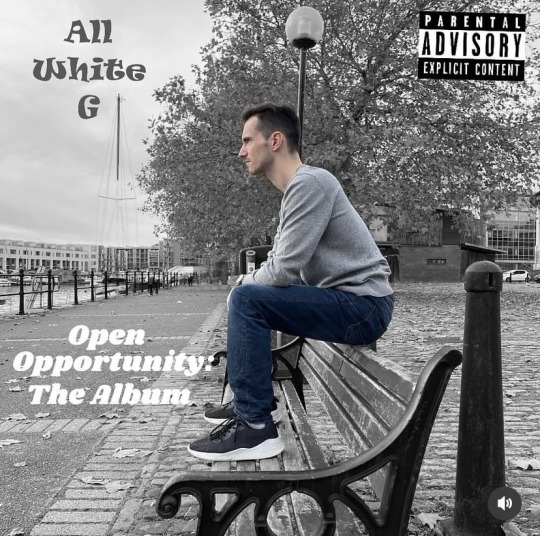
29 year old Ryan Kelly is a rapper from Bristol known as All White G. He’s been making Hip Hop since 2015 and ‘Open Opportunity’ is his second studio album following 2019s ‘1994: The Bristol Rapper’. He has no shortage of material out there as Ryan has also released a bunch of singles and 8 freestyle compilations.
Open Opportunity has been in development since 2020 and over this time 8 singles have been released teasing towards it. The final product features 13 songs, standing at 47 minutes in length.
Conceptually Open Opportunity is about All White G revealing his true self no matter what other people think, everything good and bad, nothing is off limits. Ryan approaches topics such as his own mindset, autism and his mental health making for a personal and telling record.
Favourite Song: Autistic Angels
Autistic Angels for me is the most personal song on the album. Ryan talks about his life and how autism effects him, mentioning things like how communication and social interaction are massive barriers for himself but he fights everyday to overcome them. This is something that I relate to deeply as I’m autistic myself and have been through similar struggles. The world can be a scary and judgmental place but it only feels that was until you find your place. This is why this track feels uplifting to me, combined with the beautiful use of sampling It’ll All Be Over by The Supreme Jubilees which feels comforting, like a blanket being wrapped around you to stop the shakes. Autistic Angels is a wonderful song and is an achievement in perception.
Wide Awake
Wide Awake for me is the most emotional song on the record as it deals with negativity and rudeness from other people and its effect on Ryan’s mental health, resulting in sleepless nights from all of the bad thoughts in his head. I can really feel Ryan straining his voice here, all of these words truly mean something to him and it feels like that he’s removing a big weight from his chest. His performance here is truly inspiring and the instrumental only adds to it mixing harsh guitar riffs with somber piano chords.
Judas Kiss (feat. Ryder D’Arelli)
For me Judas Kiss has the best instrumental on Open Opportunity. With the acoustic guitar, piano and click clack beat it has a natural feeling to it where it feels very fragile. In my mind within the way is progresses, it portrays an artist painting on an easel in front of me. It reminds of the production from the first Rizzle Kicks album with how experimental it is. Ryan’s vocals work very well alongside the beat here with him finding the nuances within it and stringing in rhymes together where needed making for a great flow. However with Ryder’s vocals on the hook, although catchy and well performed they feel more tacked on to the back of the track, feeling more like a sample then a collaboration.
I would consider Ryan as a natural outsider artist as despite his disability, he’s learnt to rap from scratch and has been developing this talent of his for years now. Whilst he is already at a good level, I think that he has the potential to do even better.
Overall, I enjoy Open Opportunity but to me the singles outweigh the deep cuts as they are when this record is at its best. If there were less singles then there would of been more to look forward too and in turn more to be surprised by. A good sophomore effort but with time better is to come.
6/10
Below is a clip from of me playing album track Smoke & Mirrors on my stereo. Ryan very kindly burned a copy of Open Opportunity for me on CD so I could to listen too it for the review.
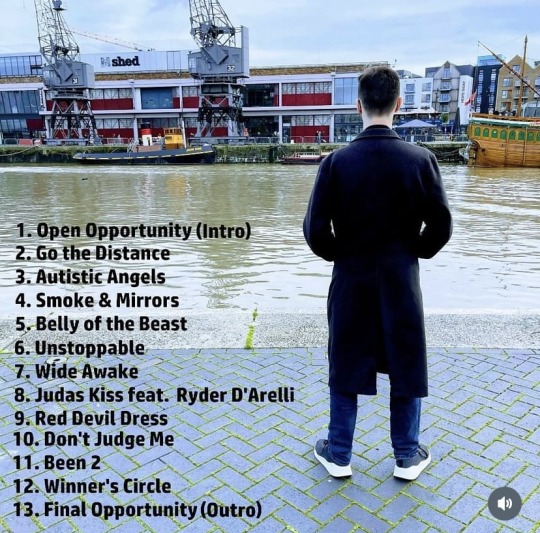
0 notes
Text
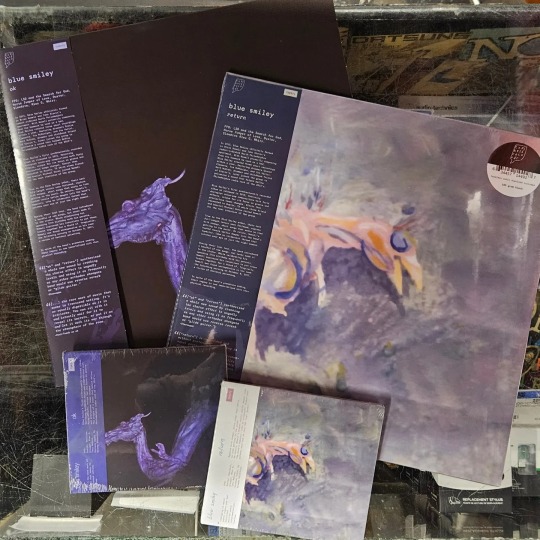
We're very happy to finally be able to stock the discography of sadly short-lived Philadelphia group blue smiley thanks to new LP and CD reissues out via Topshelf Records
A shop favourite over the past few years, their concise pop-driven take on lo-fi fuzzy shoegaze indie-rock results in short, snappy earworms that demand repeated listens and consistently have people in-store asking "Who's this?"
The band only released 2 albums before songwriter Brian Nowell sadly passed away in 2017, but with renewed online interest and physical editions back in print, their legacy is now rightfully immortalized.
Blue Smiley - ok (2015)
- CD $20 / LP $40
Blue Smiley - return (2016)
- CD $20 / LP $40
#bluesmiley#topshelfrecords#briannowell
0 notes
Text
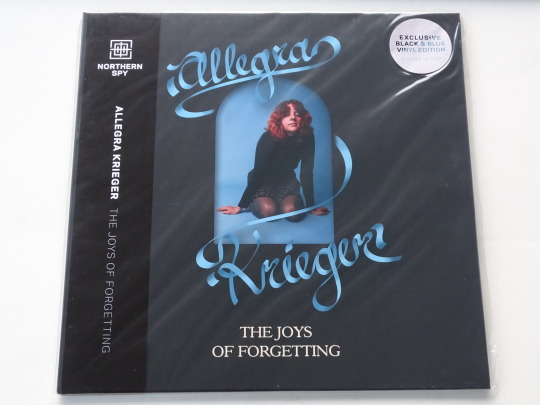
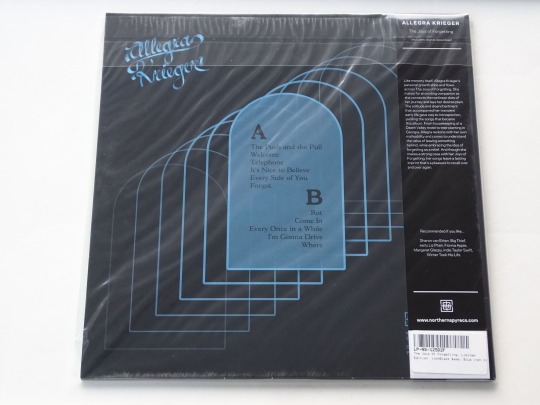
Friday, 29 September 2023:
The Joys of Forgetting Allegra Krieger (Northern Spy) (released in 2020)
You can argue this is Krieger's debut. But every site I visit claims it to be her second album. Her "debut" was Circles, a download only album that you can play on soundcloud of all places. Yes, CarSeatHeadrest released a dozen self released CD-Rs but I still count his 2015 Matador release Teens of Style as his debut. I also count 1974's Pieces of Sky as Emmylou Harris' debut even though Gliding Bird came out in 1970. Perhaps I should say "major label debut" but Matador isn't a major label in the sense that Reprise is. And actually, Reprise isn't major either. Technically. That's just me. I consider Krieger's debut to be The Joys of Forgetting. I'll never hear Circles until it gets a proper release and even then, I'll never consider it her debut.
Regardless, this is the result (again) of too many Shiners late at night while listening to sad, solemn music like this or this or even this (and that latter choice is slightly upbeat, but still deeply heartbreaking). And then when you discover that there are two pressing of this album, one on black vinyl or one on blue/black vinyl limited to a meager 100 copies, it was impossible to refuse. (Which brings me to this point: how can Northern Spy press 100 copies of this album alongside any number of the black vinyl copies and Kanine can only press 200 copies of Nicole Yun's fantastic Paper Suit and then make her grovel with crowdfunding to press physical copies of her follow up, 2023's equally excellent Matter? Please, Kanine, explain this incongruity! For crying out loud Kanine still has Eternal Summers (Yun's first band) albums in print, surely that must mean they sell!)
Above you see the cover of the album and the back of the album. This includes an obi (which isn't really an obi but I don't know what else to call it other than a band wrapped around the album that is movable). Below you can see the back of the obi (sideways to preserve space). Check out the list of artists it compares Krieger to. I've never heard that last band listed but I certainly dig the name: Winter Took His Life. I'll be checking that name out!

Below is a close up of the hype sticker on the cover of the plastic. This comes in one of those plastic resealable sleeves that drive me slightly crazy. I'll keep it (until it rips) and then I'll just cut out the hype sticker and drop it inside the album jacket.

The following two photo reveal the front and back of the inner sleeve.
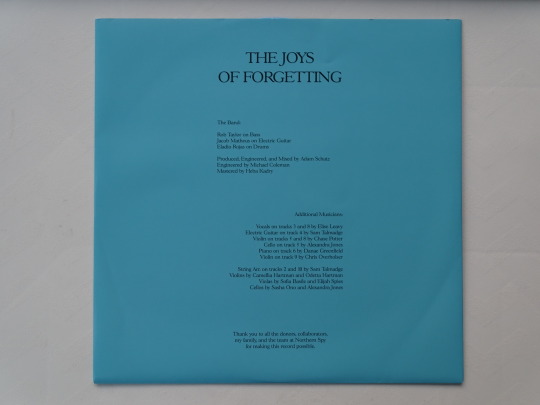

As the hype sticker says, this is pressed on black and blue vinyl. You can see both shots of the vinyl below.


The above photo was taken at 6:30 at night so it isn't very sunny. That black bar right above the inner sleeve is a reflection of the roof of my back porch. Below I close out with photos of both sides of the record label.
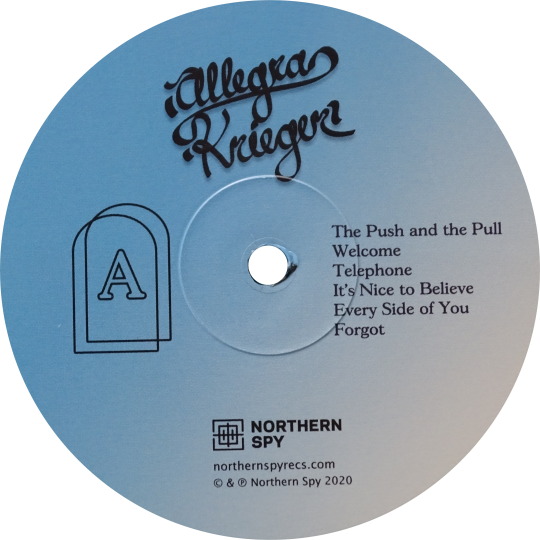
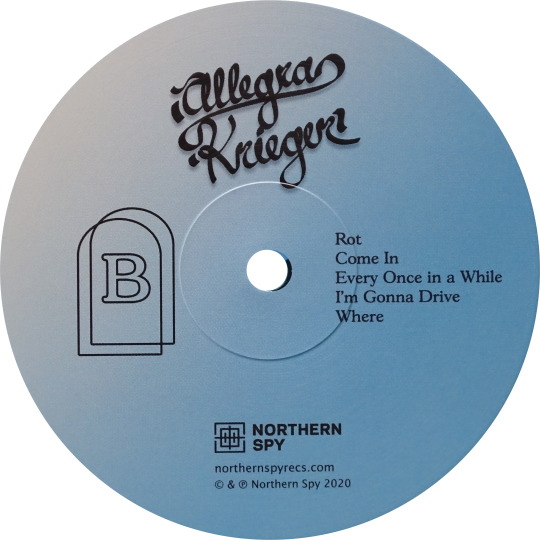
0 notes
Text

9.9.2023 Release Albedo Gravitas / luminescence
Albedo Gravitas are derived from the improvised duo group called Albedo Fantastica of Keiko Higuchi and Sachiko established in 2015 joined by Shizuo Uchida to be a trio. The kaleidoscopic voices of Higuchi and Sachiko intermingling with the piano, bass, electronics and melodica, seem to stagnate and cut up the space which to result to create their only unique improvisation. They have been constantly performing in Tokyo and released their first album Eihwaz from the French label An’archives in 2021.
This very latest one is their first studio recorded album ever. The music here appears to be a roaming in the tranquil darkness, breathing deeply and tracing the spiritual vein of gold while spotting luminescence.
artist: Albedo Gravitas
title: luminescence
format: CD
label: Musik Atlach
number: MA020
price: 12USD

TRACKS:
luminescence
fossa
vein of ore
Albedo Gravitas 2nd ALBUM RELEASE PARTY
September 9, 2023(sat)@Okubo Hikarinouma
open 19:00 start 19:30 charge 2000yen +1drink
Albedo Gravitas
guest:
清水麻八子+田畑満 / 森重靖宗+赤い日ル女

Albedo Gravitas
Albedo Gravitasは2015年に結成されたヒグチケイコとSachikoの即興デュオグループAlbedo Fantasticaに内田静男が加わり派生したトリオである。ヒグチケイコとSachikoの変幻自在なヴォイスにピアノ、ベース、エレクトロニクス、メロディカ等が絡み、空間を淀み引き裂くような独特の即興演奏。都内でコンスタントにライブを行い、2021年にはフランスのレーベルAn’archivesよりファーストライブアルバムEihwazを発表。
今作は初のスタジオレコーディングアルバムである。静かな暗闇の中の彷徨のように深く息をつき、燐光を見出しながら魂の鉱脈を辿る。

清水麻八子+田畑満
清水 麻八子(シミズマヤコ)
大学卒業後NewYorkに渡り
リンカーンセンターのAlice Tully Hallに於いて“BlackShips”芸者役でデビュー。
その後オーストリア・ウィーンにてSona Gazarian女史の下で研鑽を積みウイーン国立音楽大学マスターコース修了。
帰国後上野耕路オーケストラのボーカリストとして活動。映画・ドラマの挿入歌や、坂本龍一プロデュースコンサートに出演。
映画「音量を上げろタコ!何歌ってんのか全然わかんねぇんだよ!」では、主演の阿��サダオ、吉岡里帆への歌唱指導の他、ゆめうつつ役としての映画出演と劇中歌を担当。
杵屋弥吉の創作長唄「赤い月」にサロメ役として国立劇場に出演。その他日本武道館での国歌独唱。
田畑 満(タバタミツル)
京都出身。 1982年より音楽活動開始。 これまで、のいづんずり / BOREDOMS/ Leningrad Blues Machine / YBO2/ZENI GEVA / Acid Mothers Temple /ガセネタなど、常に日本の音楽シーンの重要バンドで活躍しつつ、海外ツアー、多数のセッションも精力的にこなし、自宅録音によるソロ・アルバムも国内外のレーベルよりリリースしているギタリスト。現在はZZZoo、20Guilders、Tigris Flowers、RQRQ、痛郎、ザ・スターリンのイヌイジュンとのドラム&ベース・ユニットINUY & TABBIE、lemonsoursなどのグループで活動。twitter, Instagram, Facebook

森重靖宗+赤い日ル女
赤い日ル女 / Akaihirume
歌手。自作曲の演奏のほか、多様な発声による即興表現や声そのものを素材に、単独での演奏や様々な分野の表現者と共作、共演活動をしている。
森重靖宗 / yasumune morishige
音楽家。声、エレキベース、ピアノ等の楽器を用い、即興演奏を中心に音楽活動を行う。灰野敬二率いるロックバンド、不失者のベーシストとしても活動。
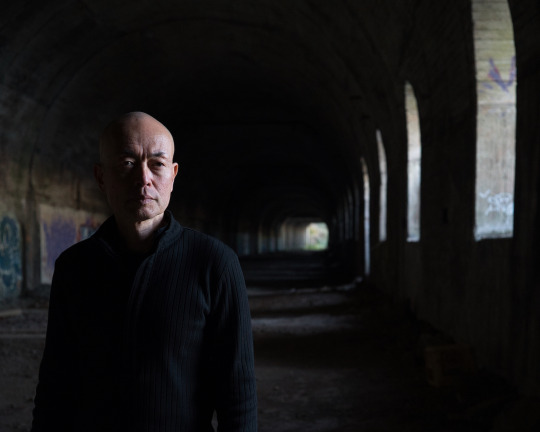
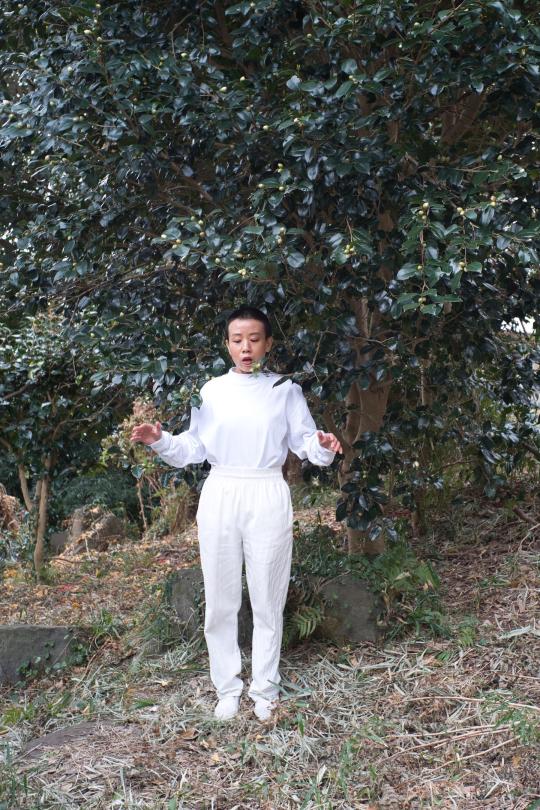
1 note
·
View note